Welcome to Lake
Discover places to stay and unique experiences around the world.
- How It Works
Home - Blog - Ice Sailing 101: Mastering the Frozen Adventure in No Time

Ice Sailing 101: Mastering the Frozen Adventure in No Time
David Ciccarelli
August 27, 2024
In this article
Get started.

Ice sailing, also known as ice yachting, is a winter sport that offers a unique and exhilarating way to harness the power of the wind. Picture yourself skimming across a frozen lake at breathtaking speeds, the crisp air whipping past as you steer your sleek vessel over the ice. It’s sailing, but with a twist—trading water for ice and waves for the glassy expanse of winter landscapes.
Iceboats come in various styles, from nimble, one-person crafts to larger, crew-operated vessels designed for different conditions. Popular classes like DN, Nite, Renegade, and Skeeter each offer distinct experiences, with designs that maximize speed and maneuverability on ice.
The Midwest is a prime region for ice sailing enthusiasts, with states like Wisconsin, Iowa, Illinois, and Indiana leading the way. Madison, Wisconsin, in particular, stands out as a historic hub for the sport, home to the Four Lakes Ice Yacht Club—a vibrant community with over a century of ice sailing tradition.
As you prepare to embark on this winter adventure, here’s what you can expect from the thrilling world of ice sailing:
Wind: Just like traditional sailing, ice sailing relies on the power of the wind to move across the ice. A good breeze is essential to reach high speeds, but always make sure to monitor the weather conditions for safety.
Safety gear: Dress warmly and wear a helmet, goggles, gloves, and ice grips or cleats on your boots. Safety should always be your top priority on the ice.
Tactics: Much like soft-water sailing, ice sailing requires mastering certain skills such as tacking, jibing, and controlling the sail according to the wind direction.
Regattas: Ice sailing competitions, or regattas, are held during the winter season. These events test not only your sailing prowess, but also your ability to adapt to the unpredictable ice conditions.
Defining Ice Sailing: A Thrilling Blend of Speed and Skill

Ice sailing, often referred to as ice yachting or ice boating, is a thrilling winter sport that merges the principles of sailing with the fast-paced dynamics of gliding across frozen surfaces. This unique activity takes place on frozen lakes or rivers, where specially designed iceboats—equipped with sharp metal runners—skim across the ice at exhilarating speeds, often reaching up to four times the speed of the wind propelling them.
An iceboat typically consists of a lightweight frame, known as the backbone, which serves as the vessel’s central support. Attached to this backbone are three runners: two side runners that maintain balance, and a steering runner located at the front, which is controlled by foot pedals or a tiller. This streamlined design minimizes friction, allowing iceboats to achieve impressive speeds, sometimes exceeding 60 to 80 miles per hour in optimal conditions.
There are several popular classes of iceboats, each with its own distinct characteristics. The DN class, named after the Detroit News where the design was first published in 1937, is one of the most widely used and competitive iceboats globally. The Nite class, known for its stability and ability to carry two passengers, is a favorite for recreational sailing. The Renegade and Skeeter classes, larger and more powerful, are often seen dominating the ice in competitive races, especially in regions like the Midwest.
The Midwest, particularly Wisconsin, is a hotspot for ice sailing, with iconic locations like Lake Mendota in Madison drawing enthusiasts from all over. Madison is home to the renowned Four Lakes Ice Yacht Club, where sailors have been perfecting the craft for over a century. In this region, winter winds can range from a gentle breeze to gusts over 30 miles per hour, creating perfect conditions for iceboats to soar across the frozen landscape.
Ice sailing requires not just a keen understanding of wind dynamics but also sharp reflexes and adaptability to varying ice conditions. Smooth, black ice offers the best surface for speed, while rougher, snow-covered patches require careful navigation. But the reward for mastering these challenges is a uniquely exhilarating experience—skimming across vast, silent expanses of ice, propelled by nothing but the wind and your skill.
Brief History of Ice Sailing: From Ancient Origins to Modern Sport
Ice sailing boasts a rich and storied history that stretches back centuries, originating as a practical mode of transportation before evolving into the thrilling sport it is today. The roots of ice sailing can be traced to the 17th century, where it began as a necessity in the harsh winters of Northern Europe. In the Netherlands, where canals freeze over each winter, the Dutch are credited with pioneering the earliest forms of iceboats. Ingeniously modifying traditional sailboats by attaching runners—sharp metal blades—to the hulls, they created vessels capable of gliding across the frozen waterways with ease. These early iceboats were primarily used for transporting goods across the frozen canals of the Netherlands and the Gulf of Riga, offering a vital means of travel and commerce during the winter months.
As the centuries progressed, the utilitarian iceboats of the Dutch transformed into sleeker, faster models designed for recreation and competition. By the 18th century, ice sailing had gained popularity among the affluent classes of Northern Europe, who embraced it as a winter pastime. The design of iceboats also evolved during this period, with the introduction of a single fore-and-aft spar, known as the backbone, which provided greater stability and control. The traditional setup included three runners—two for balance and one for steering—allowing these vessels to achieve remarkable speeds on the ice.
The sport of ice sailing made its way to North America in the 19th century, where it quickly found a home on the frozen lakes and rivers of the northeastern United States and Canada. Here, enthusiasts began to form clubs and associations dedicated to the sport, laying the groundwork for organized competitions. One of the earliest and most influential of these was the Hudson River Ice Yacht Club, founded in New York in the mid-19th century. The club played a pivotal role in popularizing ice sailing as a competitive sport, hosting races that attracted participants from across the region.
As the 20th century dawned, ice sailing continued to grow in popularity, with innovations in design and technology pushing the boundaries of speed and performance. The development of lightweight, aerodynamic iceboats like the DN class—introduced in the 1930s—revolutionized the sport, making it more accessible to a broader audience. The DN class remains one of the most popular iceboat designs today, with active racing communities around the world.
In modern times, ice sailing has become a well-established winter sport, particularly in regions with reliable ice conditions such as the Midwest United States, Canada, and Northern Europe. Clubs dedicated to ice sailing can be found in these areas, where members gather to build, sail, and race their iceboats throughout the winter months. Events like the DN World Championship draw competitors from across the globe, showcasing the sport’s enduring appeal and the camaraderie among its participants.
From its humble beginnings as a practical solution to winter transportation challenges, ice sailing has evolved into a dynamic and exhilarating sport, cherished by those who seek the thrill of the wind and the ice. Whether for recreation or competition, ice sailing continues to captivate adventurers and thrill-seekers, carrying on a tradition that spans centuries.
Ice Yachts Explained: Modern Design and Dynamics
Ice yachts, or iceboats, are sailing crafts specially designed to glide across frozen surfaces on metal runners. One of the essential elements in their design is the steerable runner, which helps you navigate on ice with ease.
The DN class ice yacht is one of the most popular designs around, known for its affordable price and accessibility. Crafted with a triangular sail and relatively lightweight materials, it’s perfect for the wider ice sailing community. While DN class caters to beginners and recreational sailors, there are other ice yachts like Nite and Skeeter classes that cater to more experienced and competitive sailors.
Safety is vital in ice sailing, which is why most ice yachts incorporate features to ensure a secure and enjoyable experience. Some of these features include:
- Runners : Metal runners allow for smooth movement, stability, and control on the ice.
- Steerable runner : This special runner enables you to easily change directions and maintain control while cruising at high speeds.
- Mast and sail : Ice yachts have a mast and sail designed to handle icy conditions, often with airfoil-shaped battens to optimize aerodynamics.
Mastering the Basics: Steering and Sail Management
Steering an ice yacht, like the popular DN Ice Yacht, might seem intimidating at first, but fear not! The key to steering is understanding the wind and how it affects the sails. When sailing upwind, position your sails at an angle that captures the most power, while also keeping your boat slightly angled into the wind. Mastering tacking techniques will allow you to change direction with ease and maintain maximum efficiency.
Now, let’s talk about sail management. The sail plays a crucial role in powering your ice yacht, so pay attention to the following pointers:
- Downwind : When sailing downwind, loosen your sails to allow them to catch as much wind as possible. Remember, the goal is to be propelled by the wind pushing the sails.
- Upwind : In contrast, when sailing upwind, tighten your sails so that they’re at the optimal angle to harness the wind’s energy, propelling the yacht forward.
To ensure a great ice sailing experience, don’t forget to consider the following factors:
- Weather conditions : Icy surfaces work best for ice sailing, so make sure to check the weather forecast before heading out.
- Safety : Equip yourself with proper safety gear like helmets, life vests, and ropes. These can be lifesavers in tricky situations.
- Regattas : As you advance your skills, consider participating in regattas. They can be a competitive and refreshing way to put your expertise to the test.
Advanced Techniques: Maximizing Speed and Handling Challenging Conditions
Ice sailing, or iceboating, is an exhilarating winter sport that combines speed, precision, and passion. If you have some experience and want to up your game, here are a few advanced techniques to maximize speed and handle challenging conditions.
Tiller control : Your tiller is the key to steering and maintaining balance on your iceboat. Keep a gentle grip on it and make subtle adjustments to steer accurately. Remember, your iceboat can react fast to any changes, so avoid abrupt movements with the tiller.
Sail trim : Getting your jib and mainsail trim right can make all the difference in speed. In lighter winds, focus on promoting smooth airflow, while in stronger winds, prioritize a balanced setup for best VMG (Velocity Made Good). Keep experimenting to find the right trim that suits both the conditions and your iceboat’s handling .
Handling gusts : When gusts hit, be prepared to lean back and use your body weight to counteract the sudden increase in force. This will maintain balance and maximize speed. When the gusts subside, make sure to readjust your position.
Navigating Different Ice and Wind Conditions
Imagine yourself as a member of the Hudson River Ice Yacht Club or the Four Lakes Ice Yacht Club. You’re excited to participate in an ice sailing adventure with your fellow crew members. But before you hop into the cockpit, let’s talk about navigating different ice and wind conditions to ensure a fun and safe experience for everyone on board.
First and foremost, you should know your vessel’s capabilities. If it’s ice classed, that means it’s designed to withstand the pressures and challenges of icy waters. However, it’s essential to be cautious, as even ice classed vessels can encounter damage.
When it comes to ice conditions, always be vigilant for any changes that could impact your sailing. Navigating in ice-covered waters can cause delays, so make sure you have sufficient supplies, such as fresh water and fuel. Remember to keep moving, even if it’s at a slow pace. Work with the ice movement and weaknesses, rather than against them, to avoid unnecessary damage to your vessel.
Now let’s look at wind conditions. Superstructure icing can be a dangerous phenomenon that occurs when ice forms on your yacht’s structure, making it challenging to sail. Keep an eye on the temperature and wind force:
| Temperature | Wind Force | Icing Condition |
|---|---|---|
| Below -2.2 °C | 5 Bft | Slight |
| Below -2.2 °C | 7 Bft | Moderate |
| Below -2.2 °C | 8 Bft | Severe |
| 0 °C and below | – | Fresh Water |
The Role of Weather in Ice Sailing: Wind, Ice Conditions, and Safety Considerations
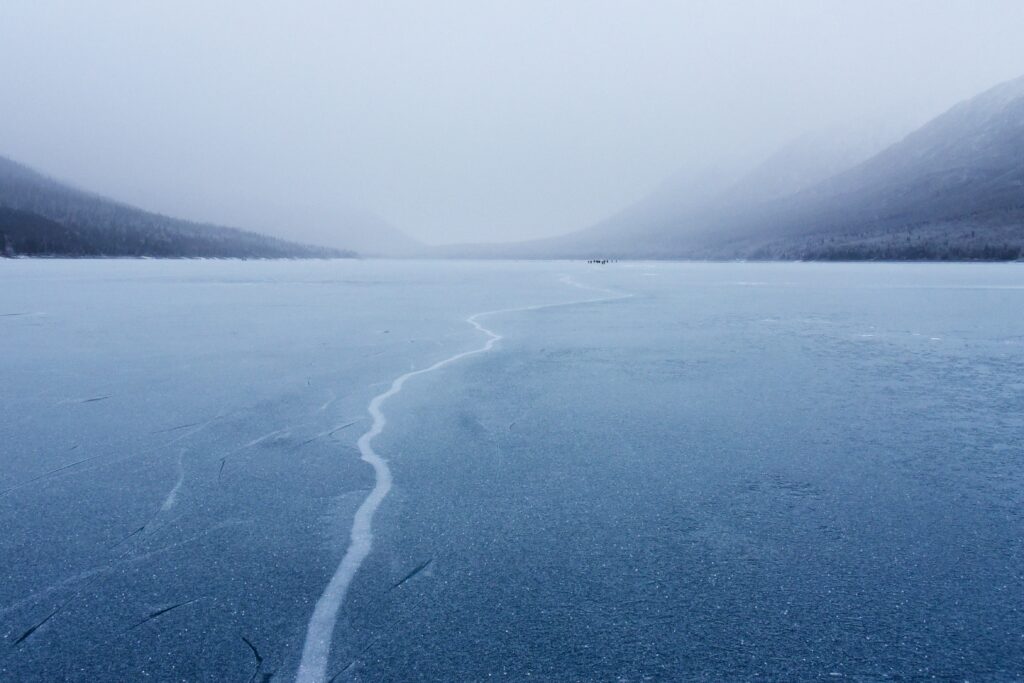
First things first, wind is your best friend during ice sailing. Since iceboats can achieve speeds of up to five times that of the wind, it is essential to know the wind conditions before setting sail. Take note of the wind speed and direction, as these will significantly impact your ability to control your iceboat. Steering and maneuvering become more challenging as the wind picks up, demanding extra care and attention on your part.
Ice thickness and quality are vital factors in ice yachting. Thicker ice is generally more stable, but it’s important to ensure there are no thin patches or cracks. Before taking to the ice, make sure to scout the area and check for any potential hazards. Keep an eye out for visible cracks and ice anomalies, as these could pose a risk while you’re sailing.
Safety should always be a top priority when it comes to ice yachting. So, here are some pointers to ensure a safe experience:
- Monitor weather conditions: Stay updated with the latest weather forecasts and avoid ice sailing during storms or extreme conditions.
- Dress appropriately: Layer up, with a focus on insulation and waterproof gear to keep you warm and dry throughout the day.
- Carry safety equipment: Equip yourself with essential items like a helmet, ice picks, a life jacket, and a whistle.
Essential Equipment for Ice Sailing: From Sails to Safety Gear
Sails : The most critical piece of equipment for ice sailing is, of course, your sail. Like regular sailing, the power comes from the apparent wind. Choose a sail specifically designed for ice sailing, as they are made to handle the unique conditions and work efficiently with the ice boat.
Iceboat : Make sure to have an iceboat properly rigged with the suitable blade and suspension system for the frozen surface. Look for a boat designed for ice sailing, offering stability, speed, and easy maneuverability.
Ice Thickness : Before taking to the ice, always check its thickness. A minimum of four inches is considered safe for ice sailing. Keep in mind that ice thickness can vary significantly over short distances, so check multiple spots.
Safety Gear : Your personal safety is crucial while ice sailing. Here’s a list of some essential safety items:
- Life jacket : Even though you’re sailing on ice, it’s still crucial to wear a life jacket in case of sudden capsizing or accidents.
- Helmet : Protect your head from potential impacts by wearing a sturdy, specifically designed sailing helmet.
- Warm, waterproof clothing : Dress for the cold weather, preferably in layers. Waterproof, insulating, and breathable garments provide the best protection .
- Gloves and boots : Look for waterproof and insulated gloves and boots designed for ice sailing.
Emergency Survival Kit : It’s always best to be prepared for emergencies. Here are some items to include in your kit:
- First aid supplies
- Emergency flares
- Extra dry clothing
- Safety knife
- Hand warmers
- Food and water
Now that you’re equipped with the right gear and knowledge, you’re ready to tackle your ice sailing adventure. Remember to always prioritize safety and stay aware of changing conditions on the ice.
Top Destinations for Ice Sailing Around the World

Ice sailing is an exhilarating sport that allows you to glide across frozen water at incredible speeds. With the right conditions and locations, you can have a thrilling experience on the ice. Here are some top destinations for ice sailing around the world.
Maine, USA : Maine is a fantastic destination for ice sailing enthusiasts. The long, cold winters provide ample opportunities for sailing on frozen lakes and ponds. Popular locations include Moosehead Lake, Sebago Lake , and Damariscotta Lake. Keep an eye out for local ice sailing events, like the International DN Ice Yacht Racing Association World Championship.
Sweden: Sweden is home to the International DN, one of the most popular ice sailing yachts in the world. The Swedish lakes and canals freeze during the winter, creating ideal conditions for ice sailing. Head to Lake Mälaren, Lake Vättern, or Lake Hjälmaren for some great ice sailing adventures.
Germany: Germany offers excellent ice sailing opportunities, with many lakes and canals freezing over during the winter months. Popular destinations include Lake Constance and Lake Müritz. Be prepared for a mix of calm and challenging sailings, as frozen canals can create narrow courses that require skillful maneuvering.
Canada: The entire country is known for its cold winters, which means plenty of ice sailing opportunities. You can find numerous frozen lakes and rivers to explore in provinces like Ontario , Quebec, and Manitoba. Keep an eye out for events organized by the International DN ice sailing communities in these regions.
Understanding Ice Quality and Safety: Thickness and Surface Conditions
Ice sailing can be a thrilling experience, but before you set your ice boat on a frozen lake, it’s essential to understand the ice quality and safety. The ice thickness and surface conditions are vital factors in ensuring your adventure is both enjoyable and secure.
Ice Thickness
Eager to try ice boating in the USA? First things first! Check the ice thickness. The thicker the ice, the safer it is for supporting the weight of an ice boat. Here’s a quick reference guide:
- 4 inches : Minimum ice thickness recommended for ice fishing or small group activities
- 5 inches : Suitable for snowmobiles and small ATVs
- 8-12 inches : Can support most small-to-medium-sized cars
- 12-15 inches : Recommended minimum for light trucks and iceboats
Remember, these numbers are for clear, blue/black ice, which is the strongest type. Slush ice has only half the strength, and river ice is approximately 15% weaker.
Ice Quality
Besides thickness, the ice quality plays a significant role in safety. Clear blue/black ice forms from the top down and is the most reliable type of ice. Now, let’s break it down into different types of ice you might encounter:
- Clear Ice : Also known as black or blue ice, it forms from top-down and is the strongest type
- White/Opaque Ice : Formed by wet snow freezing on the ice surface, it’s not as strong as clear ice
- Slush Ice : This indicates that ice is starting to melt, resulting in a significantly weaker structure
Surface Conditions
Before setting sail, inspect the ice surface for cracks, pressure ridges, and areas where water may seep through. You should also look for any signs of recent temperature changes or warm weather, which could compromise the ice’s integrity.
Famous Ice Sailing Races and Events
The Four Lakes Ice Yacht Club hosts a variety of prestigious races in Madison, Wisconsin. As one of the most active ice boat clubs in North America, they’ve been building and sailing ice boats for over a century. Joining this club will immerse you in a world of knowledge about different ice boat types, racing strategies , and more.
Now, feast your eyes on the following must-know events:
- The DN World Championship : This premier event is held annually and offers a fantastic opportunity for racing enthusiasts. Top sailors, including the likes of Tomas Lindgren, Oskar Svensson, and James “T” Thieler, attend this championship to showcase their skills.
- Green Lake Ice Yacht Club : Venturing into the Midwest, it’s impossible not to mention the prestigious Green Lake club in Wisconsin, which also hosts its fair share of ice sailing events. Harry Melges, a world-record holder, and ice sailor extraordinaire is a notable member of this club.
Fitness and Training: Physical Preparation for Ice Sailing
To best enjoy recreational ice sailing, you’ll want to build a solid aerobic base. Activities like running, cycling, and rowing are excellent ways to increase your cardiovascular endurance. If you’re able to, try incorporating land sailing into your routine – it’s not only a fun alternative, but it also helps build relevant skills for ice sailing.
Now that your heart and lungs are pumping, let’s not forget about strength training. Ice sailing demands both upper body and lower body power. Here are a few exercises to include in your workout plan:
- Upper body: Chin-ups, lat pulls, and inverted rows.
- Lower body: Single-leg squats, leg extensions, and leg curls.
- Core: Planks, sit-ups, and leg lifts.
Remember, a well-balanced exercise plan should not cause muscle imbalances. Mix these exercises up, and you’ll be well on your way to becoming fit for ice sailing.
Lastly, don’t underestimate the importance of agility and balance training. Ice sailing can be pretty fast-paced, so being nimble is crucial. Adding exercises like single-leg balance drills and lateral hops to your routine will give you that extra edge on the ice. And hey, why not throw in some yoga for good measure?
Before hitting the ice, make sure to properly inspect and prepare your ice sailboat. Inquiring about rigging services like Sailcrafters Loft and Rigging can be an easy way to ensure your equipment is ready for the adventure.
Now that you know how to physically prepare yourself for ice sailing, it’s time for you to slide into this exhilarating sport. So, bundle up and have a blast out there!
Mental Preparation: Strategy and Focus in a High-Speed Environment
Ice sailing is not just a test of physical skill, but also demands strong mental abilities. To excel in this high-speed sport, you need to be well-prepared mentally. You can do this by following some key guidelines .
Firstly, always stay calm and focused, no matter how fast the conditions are. In areas like the Netherlands and Lake Winnebago, where ice sailing is popular, blustery winds and freezing temperatures can be intense. Don’t let the cold and speed overwhelm you; instead, take deep breaths, and maintain your composure.
To stay sharp on the ice, it’s crucial to have a plan before setting sail. Keep these points in mind when strategizing:
- Safety precautions: Be aware of possible hazards on the ice, such as open water or other sportsmen.
- Wind conditions: Understand how the wind will impact your course and adjust accordingly.
- Strengths and weaknesses: Know what aspects of your technique need improvement, and focus on honing those skills.
While creating your plan, consider using these mental skills training techniques:
- Visualization: Picture yourself successfully completing your race or run on the ice.
- Positive self-talk: Encourage yourself with motivating statements like, “I’m ready” or “I can do this.”
- Set small goals: Break your race into smaller sections, focusing on one at a time.
So, lace up your ice sailing boots with a cool head, and maintain focus on your strategy to conquer the high-speed environment!
Essential Safety Practices and Emergency Procedures

First and foremost, respect the lake. Keep in mind that sailing the entire lake shore to shore in all directions is almost impossible. Open water, thin ice, expansion cracks, and ice heaves can all be potential hazards. To stay safe, always check the ice conditions before you set sail.
When it comes to tacking and jibing, maintaining control is the name of the game. Watch your sail, steer smoothly, and pay attention to your surroundings. Remember, iceboats normally travel upwind, so be prepared for sudden gusts.
A table of essential safety gear on your iceboat can go a long way. Here’s a list of must-haves:
| Safety Gear | Purpose |
|---|---|
| Helmet | Protect your head during spills |
| Lifejacket | Ensure flotation in case of |
| Ice picks | Aid in self-rescue on thin ice |
| Throw rope | Help rescue others in distress |
When it comes to achieving maximum speed while ice sailing, keep an eye on your competitors and make sure you have excellent visibility to avoid accidents. Keep your distance from other boats and watch out for potential obstacles on the ice.
In case of emergencies, you should always know where the through-hulls are and check them regularly. Make sure to have at least two big manual pumps (ideally diaphragm-type) on board that can be easily moved. Keep emergency repair materials handy (e.g., pre-drilled plywood, epoxy, plugs, etc.).
Courses and Learning Resources for Beginners
NauticEd offers a comprehensive selection of sailing courses for both beginners and experienced sailors, which you can apply to ice sailing. You’ll learn the ropes, essential safety skills, and practical sailing techniques. Some other resources to look into are ASA 101 and RYA Day Skipper Theory which also provide great foundational knowledge.
Consider joining a local ice boating club to make your ice sailing experience even better. You will meet others who are passionate about the sport and gain access to valuable resources, workshops, and instructors, like the Nite Class. Plus, nothing beats hands-on experience and learning directly from seasoned ice sailors!
administrator
David Ciccarelli, is the Founder and CEO of Lake. He is based in Toronto, Canada, and is an expert in management, business administration, strategy, product development, and customer experience. His educational achievements include the Owner President Management Program at Harvard Business School (2019-2022) and the QuantumShift Program at Ivey Business School in 2017, aimed at CEOs of growing businesses.
- Ice Sailing
Related Posts

May 14, 2024
5 Cottage Skills to Teach Your Kids
Are you looking for ways to get your kids involved […]

August 18, 2024
Swimming in a Lake: A Refreshing Guide to Safety and Fun
Swimming in a lake can be a refreshing and enjoyable […]
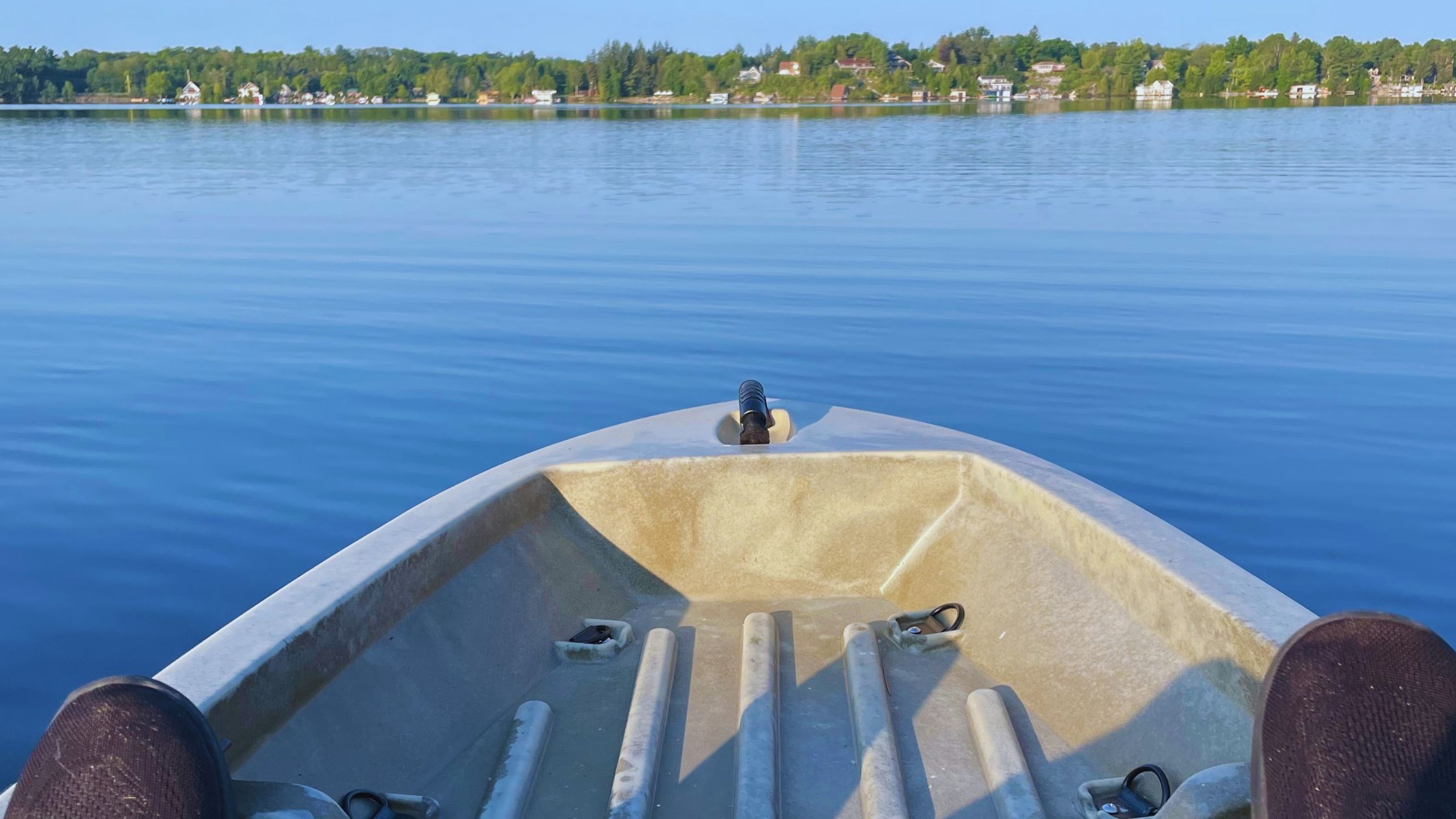
Kayaking Essentials: 7 Tips for a Safe and Fun Experience
As a kayaker, I can’t wait to share the excitement […]
Don't have an account yet? Register
Already have an account? Sign In
Reset Password
Please enter your username or email address, you will receive a link to create a new password via email.
LATEST NEWS
2025 notice of dues.
by Deb Whitehorse | Sep 26, 2024
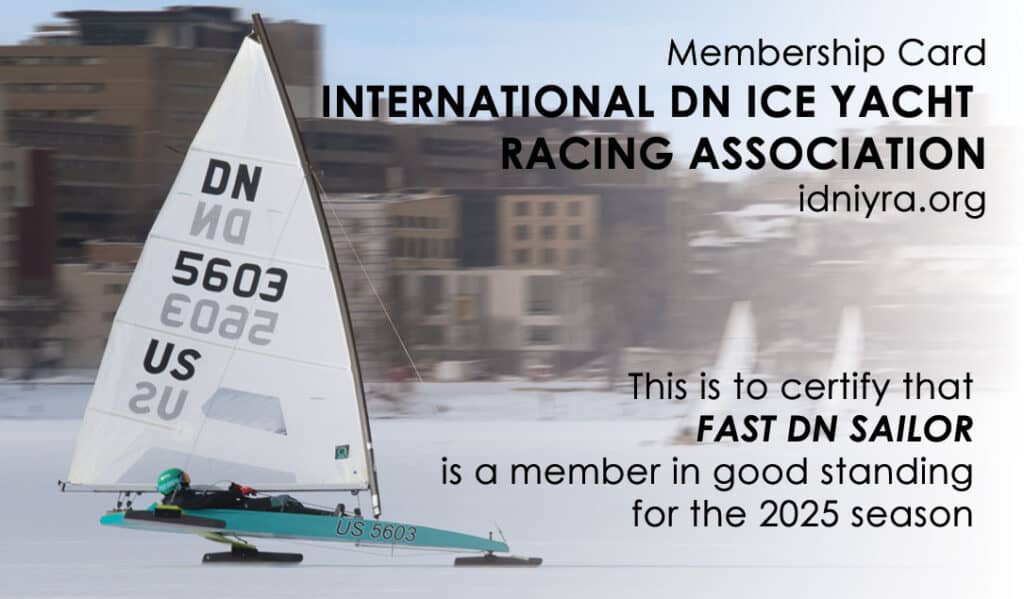
Membership Page Attention all DN sailors! It’s time to renew your membership for the 2025 season. Your membership is more than just dues; it’s a contribution that helps keep the world’s most popular iceboat class alive and thriving. Your support enables us to maintain our website, create our Yearbook and Runner Tracks newsletter, organize world-class regattas, and keep our safety equipment in top condition.
Annual memberships are available for $27 for the year, but we also offer sustaining memberships at three levels for those who want to give a little extra to support the class:
- Bronze: $40
- Silver: $50
A sustaining membership is for those who love the sport and want to contribute more toward its success. Every dollar beyond the standard membership fee goes directly back into the class, helping fund everything from event logistics to the promotion of DN ice sailing. It’s a way to give back and ensure the continued growth of the sport.
Click here to renew or begin your membership.
Thank you for supporting the IDNIYRA!
Runner Tracks Newsletter September 2024
by Deb Whitehorse | Sep 5, 2024
Runner Tracks
The online magazine of the international dn ice yacht racing association, current issue: september 2024.
Whether you are an experienced ice boater or a newcomer, Runner Tracks newsletter is the ultimate resource for everything related to ice boating. Check out the complete online library here.
RUNNER TRACKS IS AVAILABLE IN THREE DIFFERENT FORMATS: Flipbook Magazine Download pdf file (best for tablets) Download single page pdf (best for phones)
IN THIS ISSUE
- Remembering Stan Macur P111
- Let’s Try Random Starts by Robert Cummins
Interview with PJ Dwarshuis and Mischa Heemskerk: Exploring the DNA ‘DN’ Rig Design
by Deb Whitehorse | Sep 4, 2024
Link to video.
Discover how the innovative new A-Class catamaran mast design was heavily influenced by the DN iceboat rig. (With a shout-out to Robert Gracyk P31.) For more insights, don’t miss the Runner Tracks article detailing the history and evolution of the DN mast. Link here.
by Deb Whitehorse | Sep 1, 2024
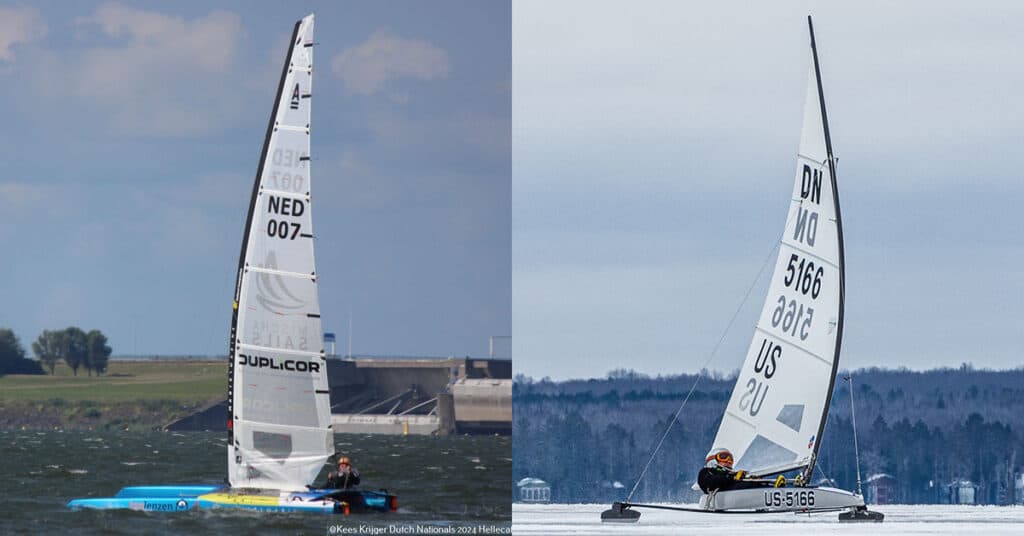
Photo left from Dutch A Division Catamaran Facebook page. Photo right from 2021 DN Nationals by Gretchen Dorian. Chris Berger US5166
As we approach the upcoming ice sailing season, there’s plenty to share about what’s been happening in the DN class over the summer. From cutting-edge developments in other sailing classes inspired by DN rigging to exciting news from the America’s Cup and the growth of our youth programs, this summer has been anything but quiet.
DN Influence on A Class Catamaran Masts The A Class catamaran community is embracing innovation inspired by iceboating, as seen in the recent Dutch Nationals. Photos from the event, shared on the Dutch A Division Catamaran Association Facebook page, highlight the “DN-mast” fitted on the DNA F1X catamarans of Mischa Heemskerk and Pieterjan Dwarshuis. Pieterjan commented on this groundbreaking rig:
“Without any doubt the future for the foiling A’s. More automatic, easier to handle, more stable to foil, and faster—just like the DN rig. The tuning process is still a challenge, but this innovation will make foilers easier, safer, and more fun.”
This DN-inspired mast design, which ditches traditional diamonds and spreaders for lowers, is being hailed as the future of foiling A Cats. As the tuning evolves, we may soon see these rigs making waves in the A Class World Championships which take place September 7 – 14 in Punta Ala, Italy.
DN Class Ties to the America’s Cup The America’s Cup is in full swing, and we have a special connection to the action this year. Maxime Bachelin , helming for the Swiss team Alinghi Red Bull Racing, has deep roots in the DN class. His father, Pierre Bachelin Z25, has been an active DN sailor for many years, competing in North America multiple times. Meanwhile, in the Youth America’s Cup , Fontana, WI sailors Harry Melges IV, Kyle Navin, and Finn Rowe— who all have DN seat time and sail Nites —also represent the USA. Ice sailing has helped shape these sailors into the top competitors they are today.
Junior Sailing: Building the Future of Ice Sailing Our North American Junior Sailing Director, Sam Bartel US1011, has been busy fostering the next generation of DN sailors this summer in Minnesota. Sam shared some great photos of junior sailors hard at work making their runner planks and learning valuable skills that will serve them well in the future.

Eight Bells: Remembering Mike Madge, DN Sailor, and Ice Sailing Advocate
by Deb Whitehorse | Aug 3, 2024
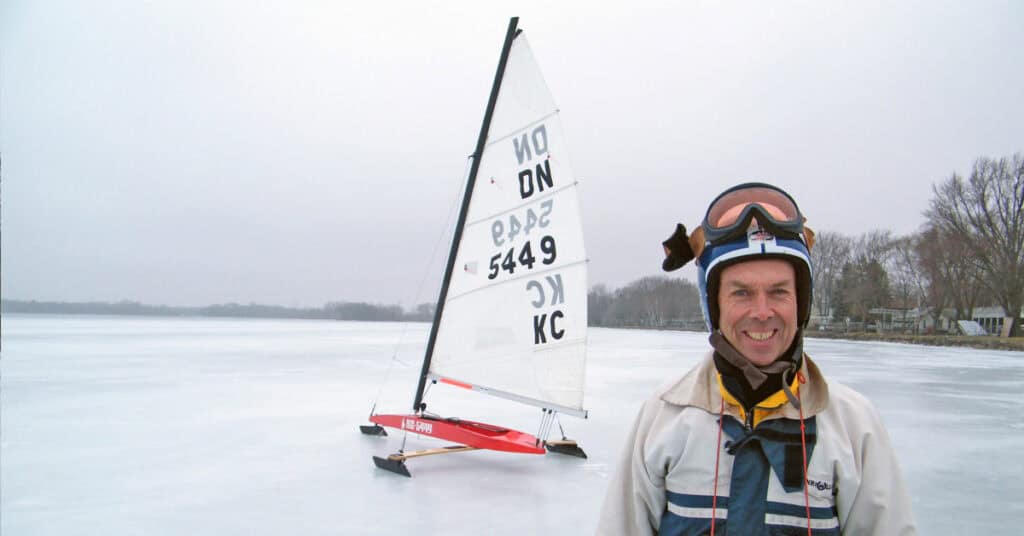
His enthusiasm helped introduce many to ice sailing in Thunder Bay. Beyond his local efforts, Mike was also known for his excellent YouTube interviews, where he engaged with the rock stars of DN sailing. He asked insightful questions, providing a platform for these sailors to share their experiences and knowledge, which enriched the ice sailing community worldwide.
Mike’s contributions to the DN class and spirit will be greatly missed. Our heartfelt condolences go out to Mike’s family during this difficult time. Rest in peace, Mike Madge.
YouTube Videos Oskar Svensson – the 18 year old future of Ice Yachting Ron Sherry – Back up to Full Speed in the DN Ice Yacht 3x DN World Champion Matt Struble: Get your DN Ice Yacht up to race pace
Remembering Stan Macur
by Deb Whitehorse | Jul 22, 2024
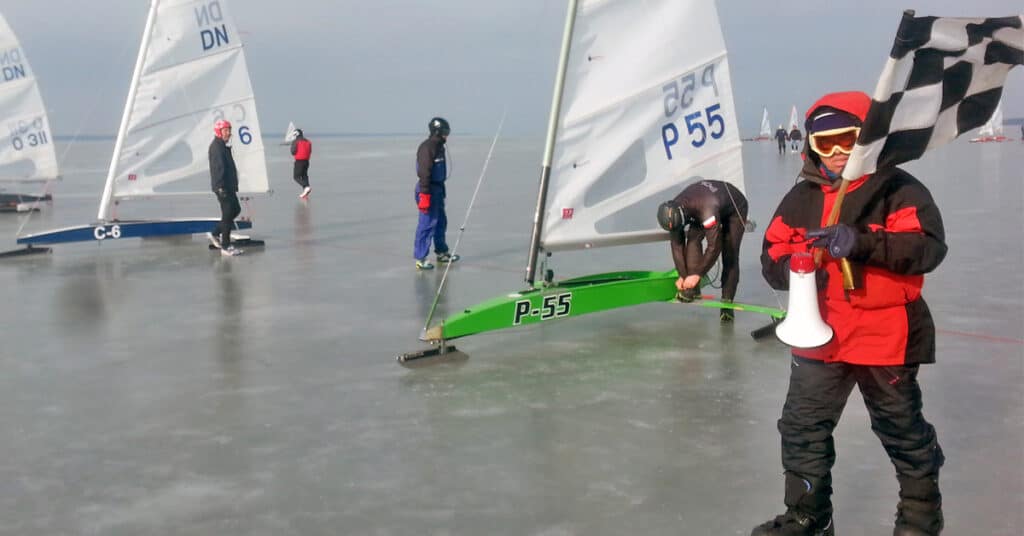
Stan walking out to start a World Championship Gold Fleet race.
It is with deep sadness that we learned of the passing of Polish ice sailing legend Stan Macur. Stan played a crucial role in the international ice sailing community, shaping the sport for future generations of sailors.
For 20 years, Stan served as the IDNIYRA European Junior Sailing Director. His contributions to the sport went beyond his administrative roles. As a competitor, Stan was formidable, placing third in the World Championships three times, securing second place in the North Americans, and winning the European Championship in 1993.

Stan’s tools of the trade, his loud hailer and horn.
His generosity also marks Stan’s legacy. Pete Johns shared his story about meeting Stan for the first time at a regatta on Hamilton Bay in Canada, before the Iron Curtain fell. Stan, touring with Russian minders, struck up a friendship with Pete and promised to build a boat for him so that Pete could compete in Europe at the next World Championship. Pete never heard from Stan during the year and didn’t know he’d have a DN waiting for him at the Worlds. Despite the communication challenges of the time, Stan kept his word. When Pete arrived in Europe, he found that Stan had built and set up a boat for him, helping him place well in the regatta. This gesture marked the beginning of a lifelong friendship between the two sailors.
Stan served as the Principal Race Officer (PRO) for many DN World Championships in Europe, where his signature battered horn would signal the start of each race.
The ice sailing community has lost a giant in Stan Macur. His legacy will continue to inspire future generations of ice sailors. The IDNIYRA extends our sympathies to Stan’s family and the Polish DN Association. The worldwide ice-sailing community will miss him.
Stan’s Obituary: To our deepest sadness, Stan Macur P-111, a Polish iceboater and a multimedalist of ice-sailing regatta on both national and international level, passed away on July 19th 2024. Stan started his sailing adventure in his teenage years. When he discovered ice-sailing, it became his life passion. Already as a junior, he won senior Polish DN Championships in 1972. Then he achieved many more successes in ice-sailing, among which there were three bronze medals in DN World Championships and a golden medal in DN European Championships in 1993. For most of his sailing career he represented the AZS Olsztyn sailing club. After finishing his career as a competitor, he devoted himself to work for the ice-sailing community, which included being a board member of IDNYIRA-Europe and leading the Professional Race Committee that conducts the main ice-sailing events: DN World and European Championships. Stan also tried to spread his passion for ice-sailing to young people. For many years he was the IDNYIRA-Europe Junior Programme Manager and also worked as a trainer. His professional life was also connected to sailing, as he constructed boats and other sailing equipment. Even though ice-sailing was his life passion, he was first of all devoted to his family and friends. He valued time spent together and his closest ones -wife Joanna and daughters Kasia, Julia and Sylwia; could always count on him. Stan, thank you for all your contributions. We will miss you a lot. The funeral will be held on July 27th 2024 in Olsztyn, starting at 12 pm in St. Francis Church (Olsztyn/Kortowo), and then at the Communal Cementery Poprzeczna in Olsztyn.
2025 International Rank List Published
by Deb Whitehorse | Jul 10, 2024
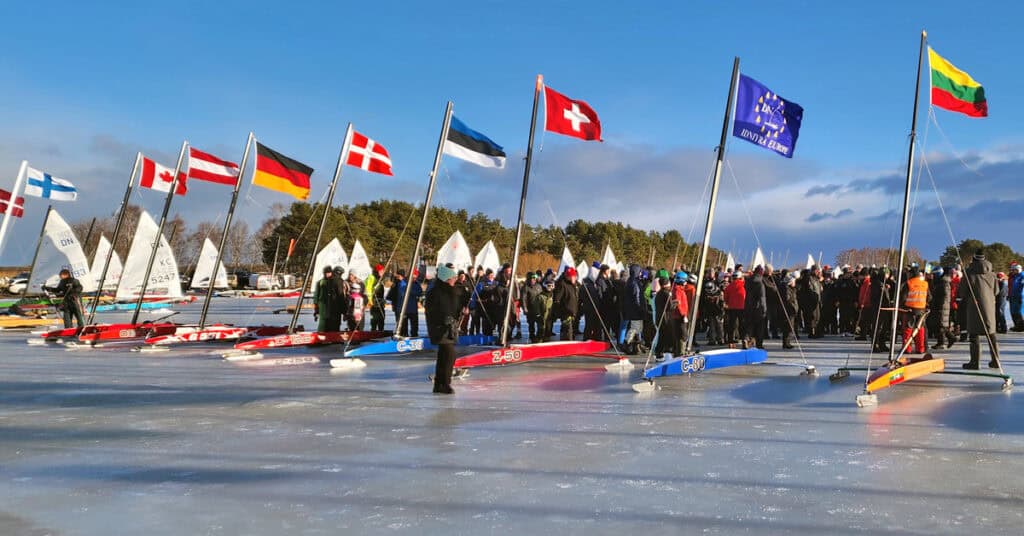
2024 World Championship Opening Ceremony on the Baltic Sea in Parnu, Estonia.
The daylight hours are slowly getting shorter which means the ice sailing season will soon be upon us. The 2025 IDNIYRA Rank List has been published. See it here. You can also see it on the DN World Portal here . The rank list is used to seed regatta fleets at continental events. Thanks to Ann Foeller for her assistance.
2025 CONTINENTAL RANKING REGATTA SCHEDULE
- 2025 WORLD CHAMPIONSHIP & NORTH AMERICAN CHAMPIONSHIP Date: February 2 – 8, 2025 Host: Central Region
- 2025 EUROPEAN CHAMPIONSHIP Date: February 22 – March 1 Host: DN Finland
From the IDNIYRA Regatta Management Agreement (RMA) 14. DN Split Fleet Ranking
The Continental Secretaries shall maintain a fleet ranking. This ranking shall be updated yearly and shall be published by October 15 using regatta results from the previous two GCs (Gold Cup), NACs (North American Championships), and ECs (European Championships). This ranking shall be the lessor of the following:
• Best finish in the Gold fleet in the previous two World Championships, North American Championships, and European Championships. • 22 plus your best finish in the Silver fleet in the previous two WCs, NACs, and ECs. • 40 plus your best finish in the Bronze fleet in the previous two WCs, NACs, and ECs. • 58 plus your best finish in the Aluminum fleet in the previous two WCs, NACs, and ECs. In the event of equal ranking for more than one sailor, the ranking which is based on the most recent race result will be considered higher.
CURRENT CONTINENTAL RANKING REGATTAS 2023 World Championship 2023 North American Championship 2023 European Championship 2024 World Championship 2024 European Championship 2024 North American Championship
All corrections must be submitted to the respective Continental Secretary by November 15. The list will be final on December 1.
Questions about your rank? Please email [email protected]
Election Results & Toledo Ice Yacht Club Members Win Mills
by Deb Whitehorse | Jun 11, 2024

Toledo Ice Yacht Club members pressed the fun and speed pedal, winning the 100th Mills Trophy Race, winning 1st in class and 1st overall.
Thank you to all who participated in voting and helped shape the leadership of our class. Your officers are committed to serving the DN community and ensuring a successful season ahead. Link to results Election Results for 2024 IDNIYRA Spring Ballot
Commodore David Frost US5358 ************************************** Option Votes Percentage Yes – I approve the candidate 80 100.00% No – I reject the candidate 0 0% Votes tallied: 80 Abstentions: 1
Vice Commodore Rob Holman US3705 ****************************************** Option Votes Percentage Yes – I approve the candidate 79 100.00% No – I reject the candidate 0 0%Votes tallied: 79 Abstentions: 2
Secretary Deb Whitehorse US2366 ***************************************** Option Votes Percentage Yes – I approve the candidate 79 97.53% No – I reject the candidate 2 2.47% Votes tallied: 81 Abstentions: 0
Treasurer Deb Whitehorse US2366 ***************************************** Option Votes Percentage Yes – I approve the candidate 79 97.53% No – I reject the candidate 2 2.47% Votes tallied: 81 Abstentions: 0
Past Commodore Robert Cummins US3433 ********************************************** Candidate Votes Percentage Yes, I approve the candidate 76 96.20% No, I reject the candidate 0 0% Warren Nethercote 1 1.27% John Harper 2 2.53% Votes tallied: 79 Abstentions: 2
The Ice Men Winneth Toledo Ice Yacht Club Sailors Win Historic Mills Trophy Race
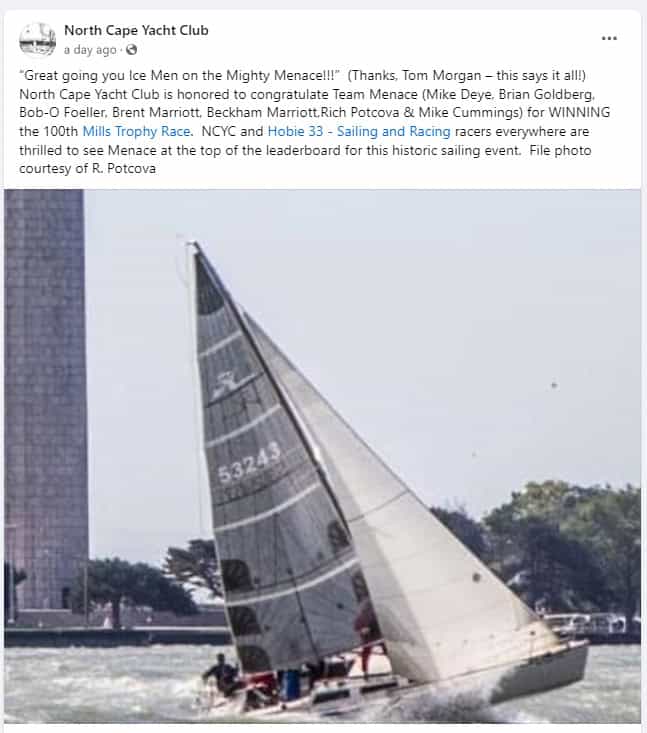
DN Class Updates: Specifications Rewrite, Elections, and 2025 Regatta Planning
by Deb Whitehorse | May 30, 2024
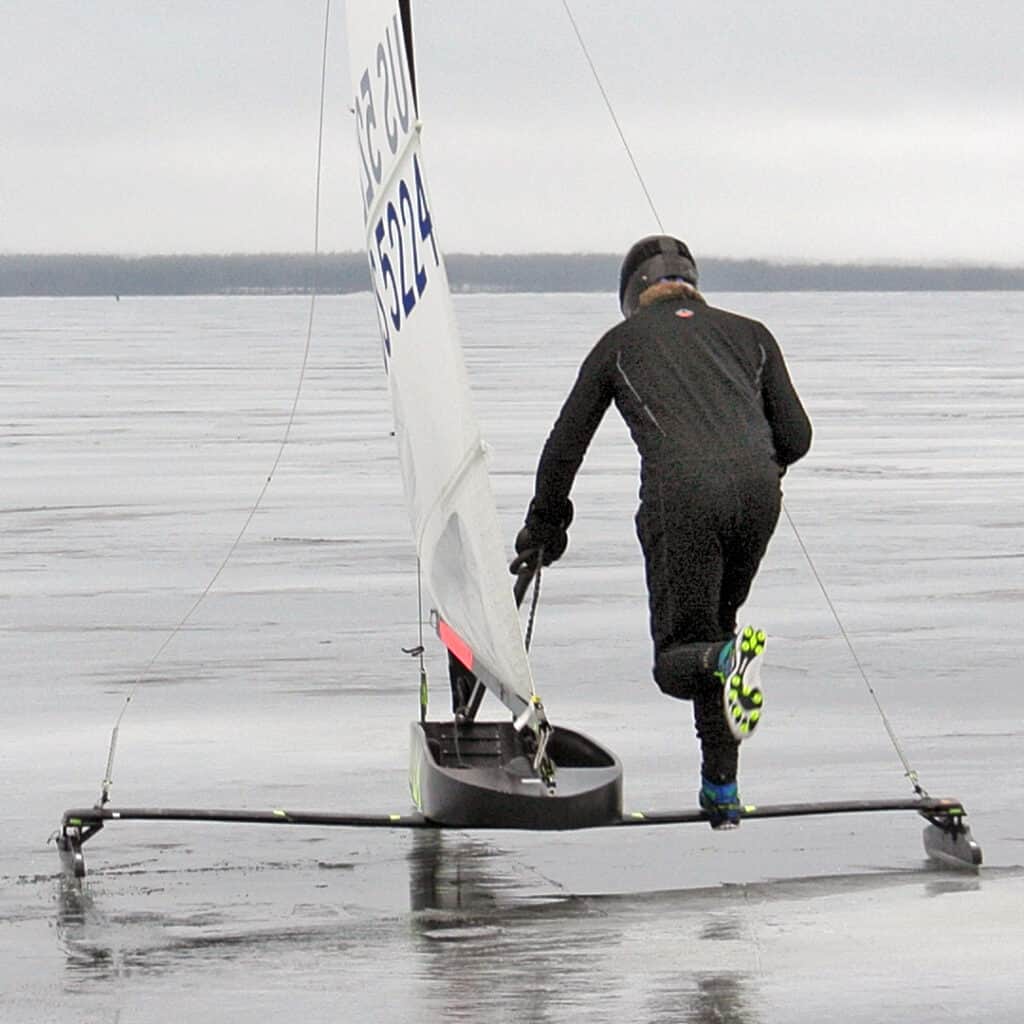
Specifications Rewrite In the fall of 2023, our class voted and approved a comprehensive rewrite of the Specifications, specifically focusing on sections A (Fuselage) and B (Runner Plank). The proposal from the Technical Committee is effective on May 31, 2024.
The main goals of the rewrite were to: 1. Incorporate the Interpretations into Official Specifications. 2. Rewrite for more user-friendly wording. 3. Enrich each section with a measurement guide and measurement drawings. 4. Consolidate fragmented sections. 5. Eliminate loopholes and grey areas by providing more precise definitions. 6. Maintain the existing specifications. (See Runner Tracks September 2022 for more information.)
The online yearbooks on idniyra.org and dniceboat.org have been updated to reflect these changes. Additionally, the specifications pages on the DN world portal (dniceboat.org) have been updated. The new drawings look fantastic online and serve as a valuable resource for our members. Links: 2024 IDNIYRA Yearbook Second Edition DN World Portal Specifications A. Fuselage: DN World Portal: Specifications B. Runner Plank
North American Officer Election Please remember to participate in the North American Officer election. The election closes on June 9, so be sure to cast your vote before the deadline. More information here.
2025 Regatta Planning We are already looking ahead to the regattas in 2025. The North American Central Region, under the leadership of Rear Commodore Peter Johanson US5633, will be hosting the IDNIYRA World Championship from February 2 to 8. Additionally, the IDNIYRA European Championship is scheduled for February 22 to March 1 and will be hosted by DN Finland.
New European Commodore Congratulations to John Winquist L601 on his recent election as the new IDNIYRA European Commodore at the European Secretaries Meeting. We look forward to his leadership and contributions to the DN community. Many thanks to outgoing Commodore Mihkel Kosk C45 for his service to the class.
Thank you for your continued support and engagement with our class. Let’s look forward to an exciting season ahead!
Notice of Electronic Ballot
by Deb Whitehorse | May 19, 2024
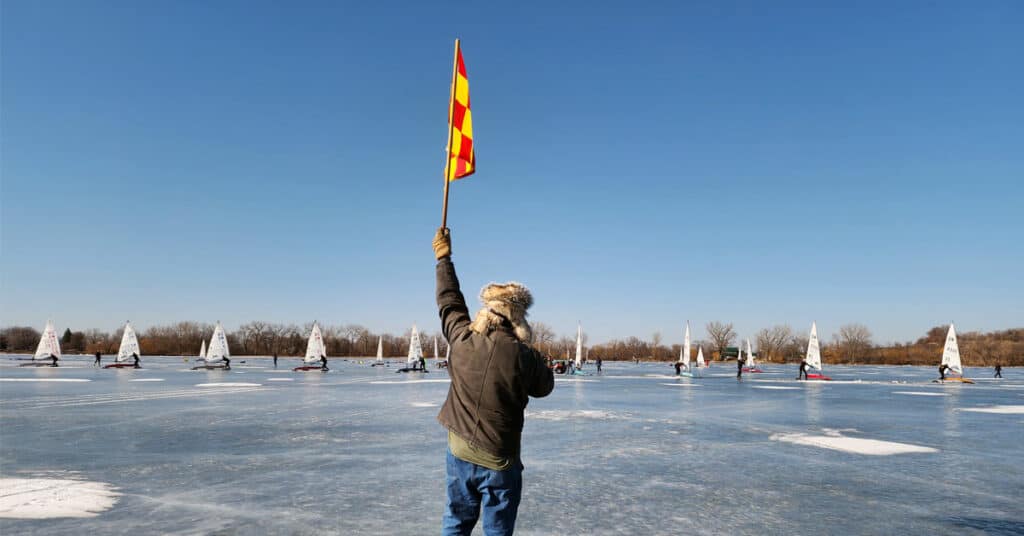
Runner Tracks Newsletter May 2024
by Deb Whitehorse | May 7, 2024
Get ready for the latest edition of Runner Tracks, which marks the end of another season. Featuring an incredible cover shot captured by Swiss photographer Gilles Morelle during the 2024 Worlds in Parnu, Estonia. Whether you are an experienced ice boater or a newcomer, Runner Tracks is the ultimate resource for everything related to ice boating. Check out the complete online library here.
RUNNER TRACKS IS AVAILABLE IN THREE DIFFERENT FORMATS: Flipbook Magazine Download pdf fil e (best for tablets) Download single page pdf (best for phones)
- Thoughts on Measurement & Building Tolerances by Warren Nethercote
- 2024 North American Championship Recap by Mike Bloom and Karen Binder
- Adventures in Iceboating – 2024 North Americans by Ron Sherry
- Regatta Results
We’d Like to Thank Our Sponsors
- Composite Concepts
- Red Wolf – DN-Parts.com
- Moore Brother Company/CSI Composite Solutions
- Hale Performance Coatings
- RKR Composites
- Toledo Ice Yacht Club
- Ullman Sails Detroit
THE DN ICE YACHT
The DN is most popular iceboat in the world. Whether you are a racer or cruiser, your $25 membership in the IDNIYRA helps to promote the art and skill of DN ice yacht construction and the sport of ice yachting on all the hard waters of the world.
2025 REGATTA DATES
- World & North American Championship Feb 2 – 8
- European Championship Feb 22 – March 1 idniyra.eu
- See full list of regatta dates here.
View Yearbook USE YOUR CREDIT CARD OR PAYPAL ORDER A YEARBOOK: $20 Click here to order a yearbook.
Current Newsletter

Enter your email address to subscribe to this blog and receive notifications of new posts by email.
Email Address

- For The Beauty Of DN Sailing
- Sailing Technique Videos
- DN Technical Videos
- DN Tech Talk from Tomek Zakrzewski DN ice yacht technical tips and tricks explained. Comprehensive source of information about DN ice yacht.
HOW ICEBOAT RACING WORKS
Iceboat.org.
- September 25, 2024: DN & DN Hull in MN September 25, 2024
Minnesota Ice Sailing Association
- NW Regatta February 25, 2024
Chickawaukie Ice Boat Club
- Meetings and Swap Meet Coming Up September 24, 2024
New England Ice Yacht Association
- Runner Tracks Newsletter September 2024 – DN North America September 12, 2024
Share this:

DN ICE YACHT RACING
Maximum speed, member countries, registered sail numbers, world championship competitors, the fastest sailing on the planet..
Fun.Exciting.Exhilarating.
Join the dn world., connect with us in europe, connect with us in north america, international dn ice yacht racing association, europe & north america, join our class. our community..
The one-design DN ice yacht is easy to transport, light, and relatively inexpensive. Carrying 60 sq ft/ 5.57 sq m of sail, it offers spirited performance and very competitive sailing. Ice yachters, from veterans to juniors, find the DN’s demands in competition a satisfying challenge. The DN has evolved into the world’s largest iceboat class with active sailors in 18 countries. A world championship regatta is held each year, alternating between North America and Europe. North American regions and European countries also host their own continental championships and regional events.

Why You Should Be Sailing a DN
“DN sailing has taken me around the world and introduced me to life-long friends – the very best people on the planet. If you make the effort to learn the sport, you can achieve results at any age, any gender, or any size. “
“I am fascinated by many things about ice sailing: the speed, the acceleration, the use of technology, and sports in nature with cold winter air. And of course, the large DN family with many friends is a reason to go ice sailing..”
“DN sailing has taught me everything – fast trajectories, apparent wind building, and much more. Sailing 5 times the wind speed has made me such a better sailor! And frankly, the spirit of the class, driven by passion, speed and friendship, is hard to beat. One of my favorite sailing boats, with absolutely no doubt ! It’s just like a drug, you become addicted at first sight!!”
More knots per dollar/euro than any other sailing
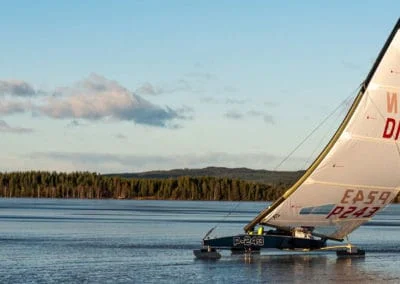
2025 DN Regatta Schedule
World & North American Championships Date: 2 – 8 February, 2025 Host Region: North America, Central Region Location: Michigan, Ohio, or best in ice North America Email Contact: [email protected] Information: DN North America idniyra.org
European Championship Date: 22 February – 1 March, 2025 Host Country: Europe, DN Finland Location: Finland or best ice in Europe Email Contact: [email protected] Information: DN Europe idniyra.eu
Faster.Transportable.Most Popular.
Start sailing the hard water. get in touch with us.
- YOUR LOCATION
- Phone This field is for validation purposes and should be left unchanged.
Specifications & Plans Rules of Ice Sailing Yearbook Championship History International Rank List Videos
Advertisement
How Ice Sailing Works
- Share Content on Facebook
- Share Content via Email
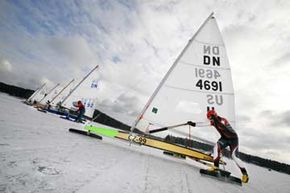
In March 2009, Briton Richard Jenkins set the world land sailing speed record by driving his vehicle, the Greenbird, at 202 kilometers per hour (about 126 miles per hour) on a dry lake bed near the border of California and Nevada. Now, Jenkins plans to sail for a new speed record -- on ice! But ice sailing is not the newest thing in the world of competitive extreme sports; rather it's a mode of transportation used at least since the 17th century.
Dutch sailors are believed to have been some of the first to experiment with ice sailing, not to break speed records, but to transport goods across frozen lakes, rivers and bays. They modified their traditional vessels by strapping blades or runners to the hull. This kept their shipping businesses functional and profitable, even during the long winter months. In the spring, when the "soft water" returned, they simply removed the runners and set sail as usual.
It didn't take long before ice sailing began to pique the interest of sportsmen and adventurers. By the 19th century, thrill seekers across Europe were building vessels especially for "hard-water sailing," as the recreational activity was known. Speed attracted people to the sport, and it was not unusual to see ice boats overtake the fastest locomotives of the day. Across the Atlantic, American sailors wanted a piece of the action. Large ice yachts began appearing on the Hudson and Delaware Rivers in the mid-1800s. Iceboat clubs also emerged. The New Jersey-based North Shrewsbury Ice Boat and Yacht Club formed in 1880 and remains in existence today.
Throughout the 1930s and 1940s, ice sailing reached its zenith. Then, interest in the sport slowly began to wane. The rise of the automobile, which brought speed to a wider audience, likely contributed to the decline. But the bigger issue was changing weather patterns. As winters grew warmer and shorter, rivers and lakes -- especially those in the Northeast -- failed to freeze deeply enough to permit safe ice sailing.
Despite global warming, ice sailing is becoming popular again with a new generation of sailors, even those who can pursue the activity only one or two weekends a year. We'll explore the reasons why in this article. Let's start with the ice boat itself, which looks like a cross between a soft-water vessel and a sleigh.
Ice Sailing Techniques
Ice sailing safety.
As with anything nautical, ice sailing has a unique and sometimes intimidating vocabulary. You might want to take a look at How Sailing Works for a good introduction. Even though these articles focus on soft-water sailing, many of the concepts and terms are the same in hard-water sailing. We've pulled some of the more common terms and organized them in the sidebar that appears on this page.
In its simplest form, an ice boat has four basic parts. The main body of the vessel, as with any watercraft, is known as the hull . Sailors in the 19th century used wood to construct the hull, but their modern-day counterparts often use fiberglass or laminate material. However it's constructed, the hull must be able to support one or two crew members, usually in a small cockpit situated a foot or two above the ice. It must also be able to float in the event a boat finds itself in soft water.
A runner plank , made of wood, laminate or metal, lies at the stern of the boat, beneath the hull. It's usually about 6.5 feet (2 meters) long and lies perpendicular to the main axis of the boat. Two runners attach to the plank, one at each end. Another runner -- the steering runner -- attaches to the bow. The steering runner comes equipped with a parking brake to prevent the wind from carrying a boat away during loading or at the start of a race. The runners look and function like big skates, allowing the boat to glide with little friction over the surface of the ice.
The sail, made of canvas or synthetic fabrics, functions as the "engine" of an ice boat. On smaller vessels, the sail may provide about 35 square feet (3.25 square meters) of surface area to catch the wind. On larger vessels, the sails can be massive. Older ice yachts that glided across the Hudson River often boasted 1,000 square feet (93 square meters) of sail.
Based on factors such as sail size and hull design, ice boats fall into different categories. The largest boats are the stern steerers , so named because the sailor controls the craft by reaching back to a tiller located at the rear of the vessel. Stern steerers were popular in the 19th century, but are less common today. Most modern ice boat sailors prefer bow steerers -- vessels controlled by the front steering runner. Bow steerers include both skeeters, which are long, thin boats with a maximum sail area of 75 square feet (7 square meters), and DNs, small, one-person vessels first introduced in 1937 during a contest sponsored by the Detroit News (hence the name "DN").
Up next, we'll look at some of the techniques hard-water boat captains use to navigate frozen rivers and lakes.
Can you talk like a sailor? These are some words you'll need to know.
- Starboard -- on the right side
- Port -- on the left side
- Stern -- back of the boat
- Bow -- front of the boat
- Fore -- at, near or toward the bow of a ship
- Aft -- at, near or toward the stern of a ship
- Mast -- vertical post or spar that carries the sail
- Boom -- a pivoting spar to which the bottom of the sail is attached, allowing the angle of the sail to be changed
- Sprit -- a pole that extends diagonally from the lower part of the mast to the peak of the sail
To sail an ice boat, a sailor must properly orient the craft so its sail captures enough wind to generate thrust. Before we talk about basic maneuvers, let's review the principles behind propulsion. Sails propel a boat in one of two ways. The first, known as sailing downwind , occurs when the boat moves in the direction of the prevailing wind. In this situation, the sailor lets out the mainsail to trap the moving air, which pushes the vessel in the direction of the wind. A sail can also propel a boat that is traveling into the wind, known as sailing upwind . In this case, the boat often uses a zigzagging technique called tacking, which we'll discuss later on this page, and the mainsail acts like a vertical wing, generating lift as the air moves over the top of the sail and down its curved surface. Because the sail is oriented upward, the "lift" is directed horizontally, not vertically. This lift pulls the boat along the ice. You can read more about the physics of lift in How Sailboats Work .
Once an ice sailor understands sail aerodynamics and how to use the wind effectively, he can move with great ease and speed. Before sailors can fly over the ice, though, they must first master the art of starting their vessels. This is usually done by orienting the boat so it's headed directly into the wind. Sailors refer to this as being in irons , which means no wind can be caught in the sails. This prevents the craft from blowing away unattended. Most iceboats also come with a brake to help secure the vessel before sailing. To get his boat moving, a sailor stands next to the vessel, releases the brake, holds the tiller and pushes, first into the wind and then at an angle to the wind. When the boat begins to move briskly, he jumps in, trims the sail and feels the vessel race forward. With little friction to slow the boat, it rapidly obtains a high speed. A sailor running a DN-class iceboat can achieve speeds of 50 to 60 miles per hour (80 to 97 kilometers per hour), while a skilled skeeter captain can reach speeds well over 100 miles per hour (161 kilometers per hour).
Steering is accomplished via a tiller , a lever that's accessible in the cockpit and connected to either a rudder skate in stern steerers or a pivoting steering runner in bow steerers. This makes it sound easier than it really is. Because ice boats don't experience the resistance of their soft-water cousins, they can be challenging to steer. Sailors must have a delicate hand on the tiller to avoid spinning out of control on the slippery ice. They must also be prepared for their iceboats to tip to one side when running fast. This is known as heeling and also occurs in soft-water sailing, requiring sailors to provide a counterbalance by shifting from one side of the boat to the other.
Tacking and jibing work the same way in ice sailing as they do in traditional sailing. Sailors use both techniques to turn their vessels. Tacking occurs when the boat turns into the wind. Jibing occurs when the boat turns away from the wind. Either maneuver can be used to swing a boat around 180 degrees. To stop, a sailor simply steers his vessel into the wind and lets the sail go free. This shuts down the boat's propulsion system, allowing the vessel to coast to a gentle stop.
Unfortunately, some stops in ice sailing aren't so gentle. In the next section, we'll review the hazards associated with ice sailing and how to avoid them.
Many people pursue ice sailing as a hobby, but others prefer to compete in ice yacht races known as regattas . A typical ice sailing race is run on a triangular course. Crews sail the course several times and earn points based on their finish. First place gets the number of entrants plus one. Each subsequent place gets one less point.
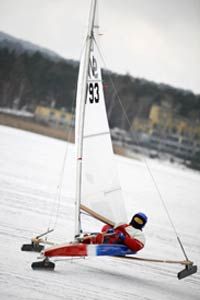
Skimming at highway speeds over a sheet of ice is not a risk-free activity. When conditions are ideal and ice boats crowd rivers and lakes, the odds of an accident increase. Two sets of rules ensure the safety of ice boat crews and prevent collisions. Fair-sailing rules require that sailors exhibit common sense, safety and good sportsmanship while on the ice. Right-of-way rules govern approach and passing so that boats maintain safe distances. Right-of-way rules for ice sailing are similar to "rules of the road" or corresponding rules for soft-water boating and windsurfing. In regattas, the race committee might disqualify a captain who doesn't follow these rules.
Sailing when it's not crowded might seem like a good solution to avoid right-of-way rules, but it's never a good idea to be on the ice alone. If you sail off the ice into soft water, with no one around to help or call for help, you might not get the help you need in time to prevent death or serious injury.
Obviously, a life jacket is a vital piece of safety equipment. So are a helmet and padding beneath your outerwear, which can protect your head and body if you fall or are thrown onto the ice. And don't forget to wear winter clothing so that you'll stay warm in the apparent winds during sailing. Apparent wind is what you feel while the ship's moving. Because it's a combination of the true wind and the wind that the boat's motion creates, it can increase the cooling effect on your body. Be mindful of numbing on your nose, ears, fingers and toes -- all body parts that are especially susceptible to frostbite.
Finally, hard-water sailing requires high-quality ice. Before you climb aboard your vessel, make sure you understand the ice conditions where you intend to sail. The best ice has no snow cover because snow stops ice growth and impedes the movement of the runners. "Black ice" is also better than "white ice." Black ice is transparent and can be more than 10 feet (3 meters) thick. It forms under calm conditions, which allow individual ice crystals to grow in long, vertical columns. Unfortunately, high-quality ice often doesn't form across an entire lake or river. Areas of open water, thin ice, expansion cracks, ice heaves and river inlets and outlets can compromise the integrity of ice, making ice sailing more dangerous. If you have any questions, consult with a local ice yacht club, which will likely provide regular reports about ice and weather conditions.
Follow these safety rules, and you'll enjoy all of the thrills ice sailing has to offer without worrying about the chills.
Lots More Information
Related articles.
- How Sailing Works
- How Sailboats Work
- How to Maintain a Boat
- How Houseboats Work
- How Ice Fishing Works
- How Luge Works
- How Snomobiles Work
- Allan, David G. "On a Sheet of Ice and Under Sail on the Hudson." New York Times. Feb. 13, 2009. (Nov. 29, 2009)http://travel.nytimes.com/2009/02/13/travel/escapes/13Iceyachting.html
- Daters, John. "Notes from a Frozen Lake: Ice Sailing in Georgetown." Colorado: The Official Site of Colorado Tourism. March 23, 2007. (Nov. 29, 2009)http://www.colorado.com/Articles.aspx?aid=42258
- International DN Ice Yacht Racing Association. "Ice Sailing Manual for Ice Optimist and DN Sailors." (Nov. 29, 2009)http://www.icesailing.org/junior/docs/IceOpti-TrainingManual.pdf
- Roithmayr, Chris. "The Early History of Ice Sailing." Sailinghead.com. (Nov. 29, 2009)http://www.sailingahead.com/information/ice-sailing.htm
- Steere, Mike. "Wind-powered craft aims to smash ice speed record." CNN.com International. April 10, 2009. (Nov. 29, 2009)http://edition.cnn.com/2009/SPORT/04/08/land.sailing.record/index.html#cnnSTCText
- Travel Montana, Montana Department of Commerce. "Boats Without Water: Ice Surfing/Sailing in Montana." (Nov. 29, 2009)http://skimt.com/other/icesailing.htm
Please copy/paste the following text to properly cite this HowStuffWorks.com article:
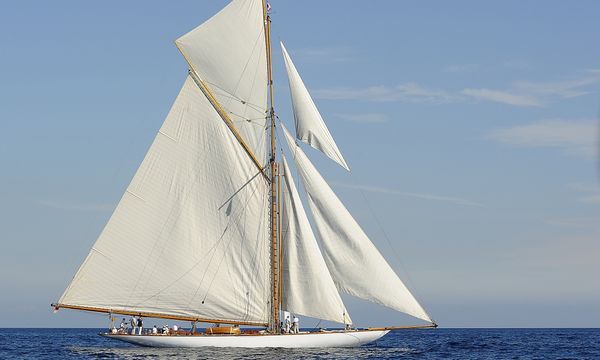
- Outdoor Activities
- Destinations
- Book Hotels, Flights & Cars
- Advertise With Us
- Cookie Settings
Copyright © 2024 MapQuest Holdings LLC, a System1 Company

Lake Homes Realty Articles and Info – LakeHomes.com
Intro to Ice Sailing
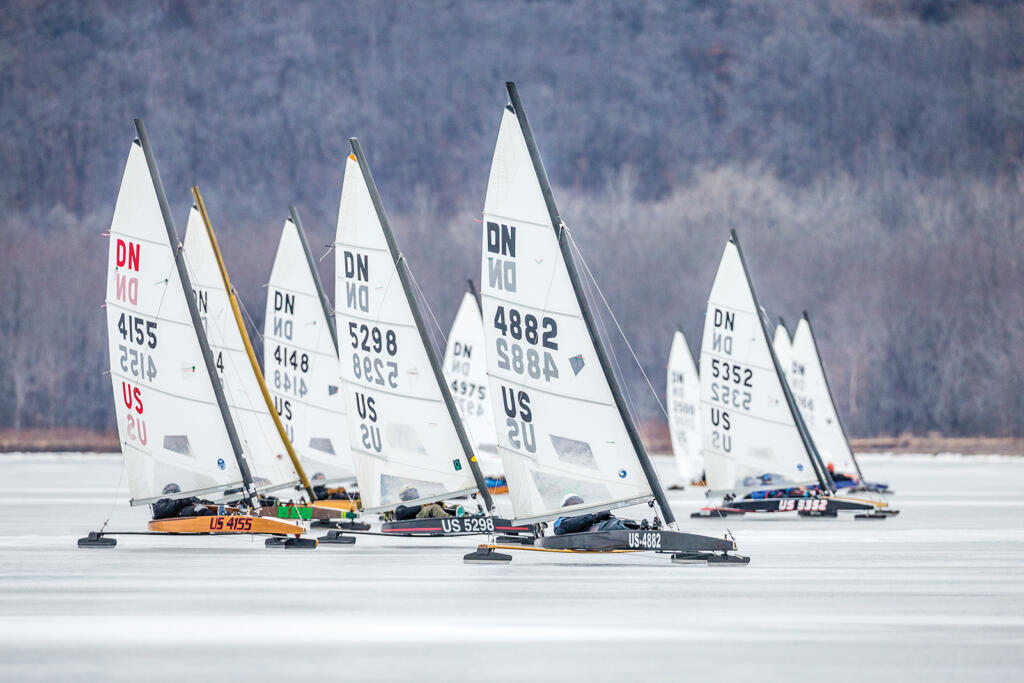
An ice boat has four basic parts—the hull, the runner plank, three skates (or runners), and a sail.
- Ice boats can reach speeds of more than 140 miles per hour.
- There are two methods of boating: sailing downwind or going upwind.
- There are several upcoming ice boating competitions in the U.S. for 2023.
Imagine feeling the breeze rush against your face as you glide across the ice at invigorating speeds. Welcome to the world of ice sailing, also known as ice boating or ice yachting—a fast-paced, thrilling winter lake sport enjoyed worldwide. In the United States, many northern lake destinations—such as Michigan, Wisconsin, Minnesota, Ohio, Indiana, and Illinois—feature lively ice sailing clubs and exciting annual competitions. Perhaps you’ve wanted to visit one of these wintry havens and try the sport for yourself. If so, check out our intro to ice sailing before you go!
What is an Ice Boat?
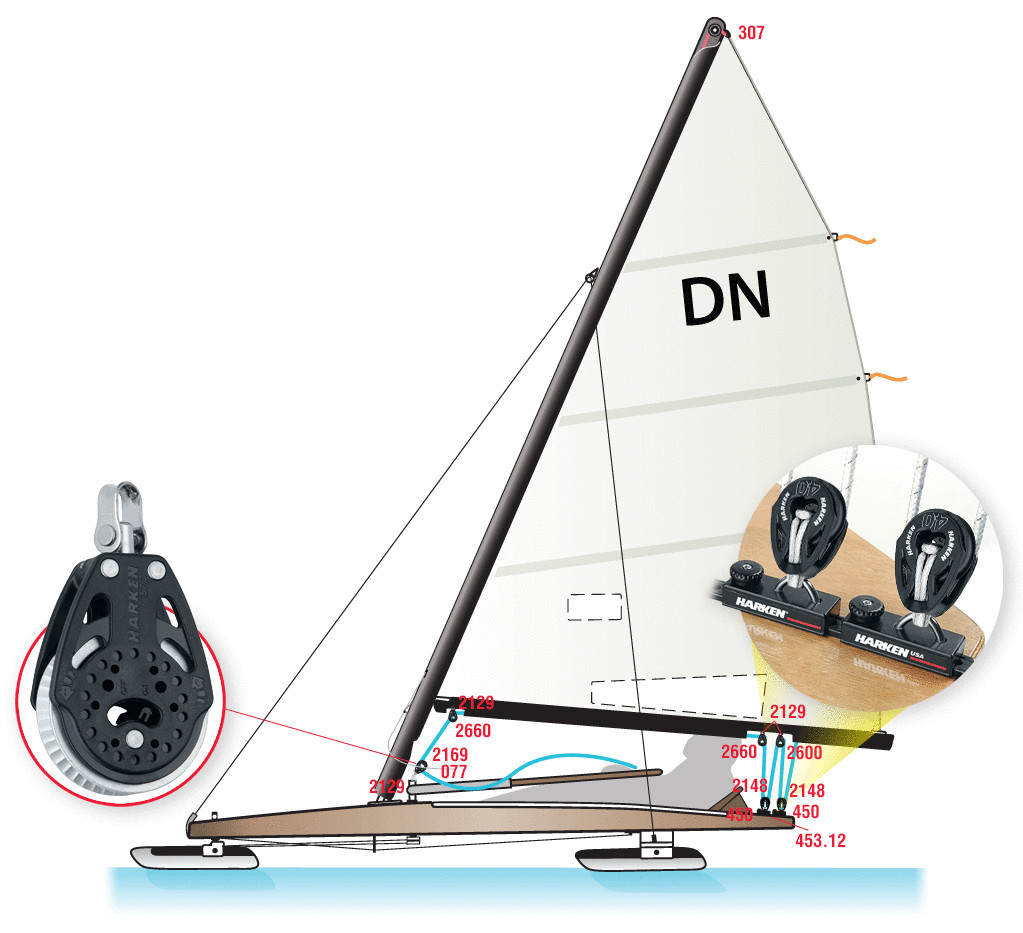
An ice boat has four basic parts—the hull, the runner plank, three skates (or runners), and a sail. The hull must support one or two crew members and have floating capabilities in case it slips into the water. Historically, ice boats have utilized a wooden hull, but today’s vessels incorporate fiberglass or laminate.
The runner plank rests at the stern of the boat and is made of wood, laminate, or metal. Generally spanning 6.5 feet long, the runner plank lies perpendicular to the boat’s main axis. Additionally, three skates—also called runners—attach to the principal runner plank. Two of these smaller runners connect to each end of the main runner and function like large ice skates. In addition, the steering runner joins the bow and features a parking brake, preventing the wind from moving the boat. The steering runner is especially useful in keeping the boat in place before the race begins.
Lastly, the sail—crafted with canvas or synthetic fabrics—powers the boat’s speed. The sail functions as the vessel’s “engine” and can span 35–1,000 square feet according to the boat’s size.
How to Ice Sail
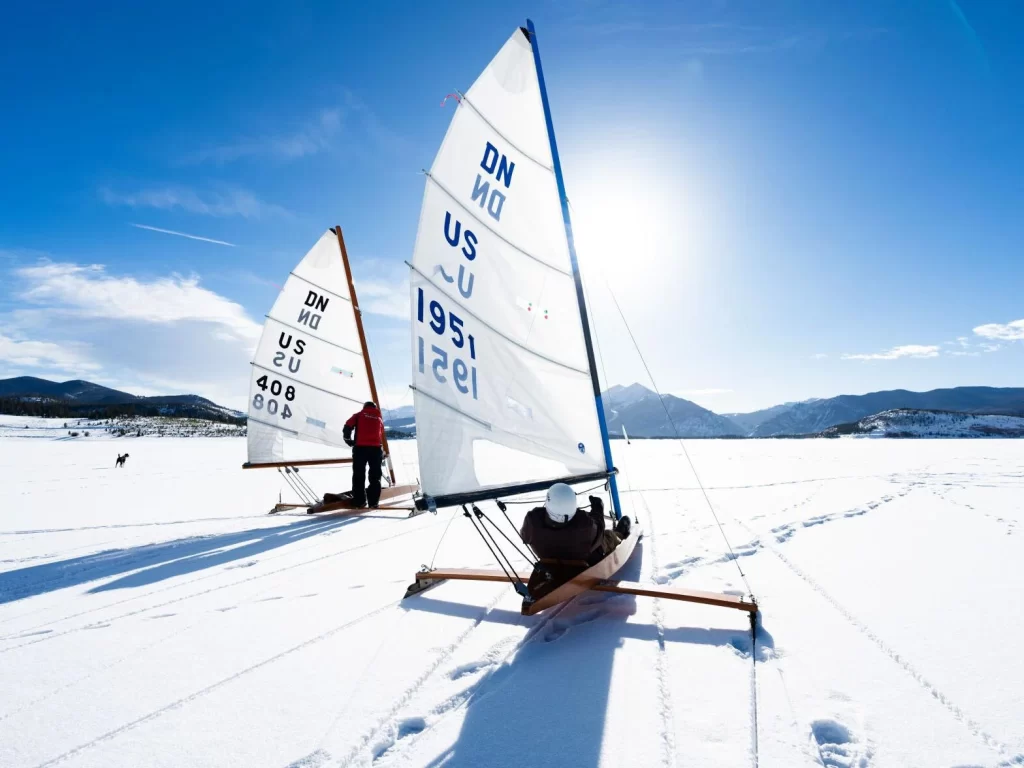
If you live in a lake area with plenty of ice and snow, the ice sailing opportunities are endless. Plus, you don’t have to worry about air pollution when you engage in this pastime. Since ice sailing is wind-powered, it is an extremely green sport.
Ice boats can reach speeds of more than 140 miles per hour, therefore, it’s essential to take some necessary precautions. If you’re new to the sport, IceBoat.org recommends purchasing an inexpensive DN -class boat, which is fairly easy to navigate and transport. They also advise racing with an ice yacht club for a couple of seasons. Then, after you become acclimated to the sport, you can upgrade your vessel and start boating solo.
When it comes to navigating, an ice boater must skillfully direct the vessel, capturing enough wind to generate velocity and power. The sail propels the boat at different speeds using two methods: sailing downwind or boating upwind . When an ice boat sails downwind, it is pushed along by the breeze and cannot exceed the wind’s velocity. However, when sailing upwind, the ice boat uses a zigzagging technique, gaining traction from the force of its own motion to augment the velocity of the wind.
Ice Sailing Competitions
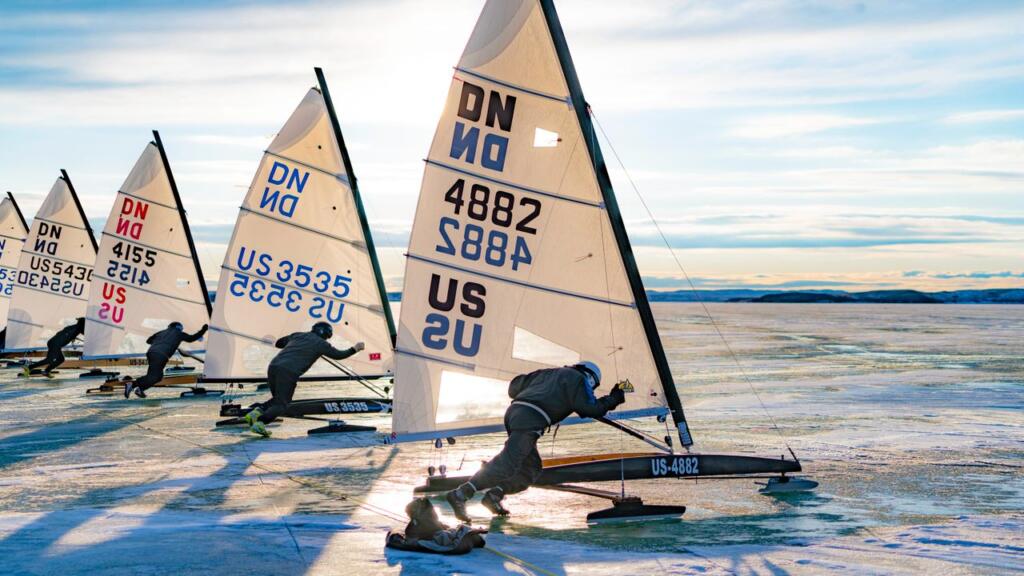
Throughout the year, various ice sailing clubs around the world hosts large tournaments. In the United States, you will mostly find these gatherings in Michigan, Wisconsin, Indiana, Illinois, Ohio, or Minnesota. Check out a few of the upcoming U.S. tournaments for 2023 here .
With our intro to ice sailing, now you know what to do and where to go. So what are you waiting for? Grab your ice boat and hop on the lake!
Where are the best places to ice sail in the U.S.?
In the United States, many northern lake destinations—such as Michigan, Wisconsin, Minnesota, Ohio, Indiana, and Illinois—feature lively ice sailing clubs and exciting annual competitions.
What are the main parts of an ice boat?
How big are the sails on ice boats.
The sail functions as the vessel’s “engine” and can span 35–1,000 square feet according to the boat’s size.
How fast can ice boats go?
Ice boats can reach speeds of over 140 miles per hour .
What are the sailing methods for ice boating?
The sail propels the boat at different speeds by using two methods: sailing downwind or boating upwind .
What is sailing downwind when ice boating?
When an ice boat sails downwind, it is pushed along by the breeze and cannot exceed the wind’s velocity.
What is sailing upwind when ice boating?
When sailing upwind, the ice boat uses a zigzagging technique, gaining traction from the force of its own motion to augment the velocity of the wind.
- Skip to global NPS navigation
- Skip to the main content
- Skip to the footer section

Exiting nps.gov
Ice yachting on the hudson.
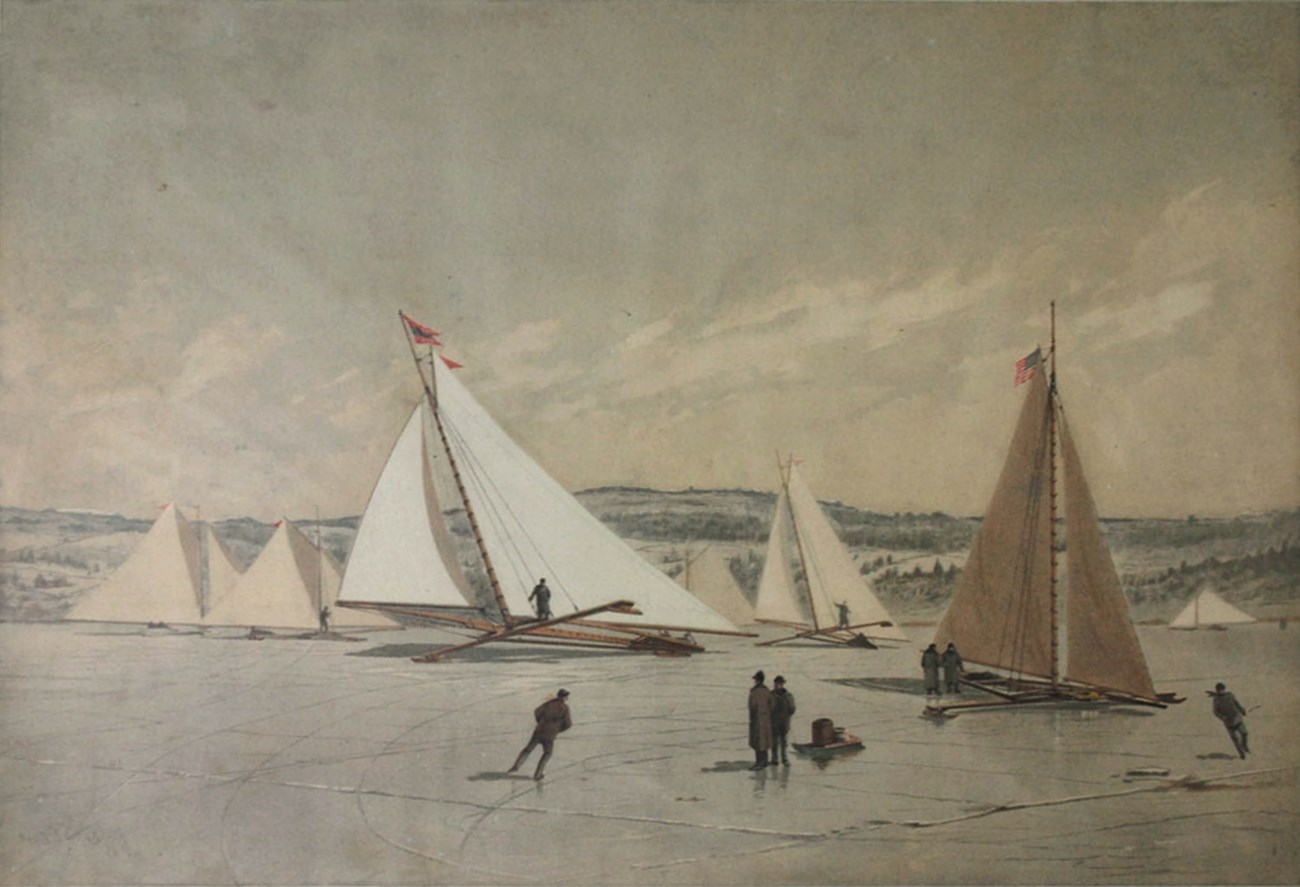
Sailing on ice began as a utilitarian mode of transportation for the Dutch, who attached metal and wood runners to the bottoms of hulled working boats. Imported to the Dutch settlements of the New World, there are accounts of cargo in the form of sheep and people being transported on the Hudson River by ice boat from Athens to Albany in the early 1800’s. Robert Livingston even tried to explode a British warship frozen in Lake Champlain with an incendiary-loaded ice boat.
The recreational potential for sailing on ice quickly took over the imagination of Hudson River Valley residents. Ice boats were redesigned as light frame craft without traditional hulls, but utilizing the traditional gaff-rigged sail pattern of Hudson River Valley sloops for propulsion, and cast iron ice skates (or runners) as media. These became in fact the fastest vehicles on earth at the time, regularly beating the trains racing up and down the shores of the Hudson. Even in modest breeze, these boats could reach speeds of 75 miles per hour.
Wealthy property owners along the Hudson River had the resources to acquire ice boats, construct buildings to house them, and hire crews to maintain them. It did not take long for the landed gentry of the Valley to compete against one another for the biggest, fastest, most beautiful of ice yachts, commissioned by special builders. The Roosevelts were one such family, and competed with their club the Hudson River Ice Yacht Club against members from New York clubs in Chelsea, New Hamburg, Orange Lake, and Athens. John Aspinwall Roosevelt and his Hyde Park neighbor Archibald Rogers were two of the most competitive and successful Captains, successively building many boats, two of which, the ICICLE and the JACK FROST, went on to win again and again, the most significant prize in ice yacht racing—the Ice Yacht Challenge Pennant of America. John Roosevelt's ICICLE, built by Jacob E. Buckhout, was the largest of the classic yachts. At 70 feet long, it carried over one thousand square feet of canvas and had to be transported on a railroad flatcar.
The Hudson River Ice Yacht Club
The Hudson River Ice Yacht Club grew out of the Poughkeepsie Ice Yacht Club founded in 1861 as the first ice yacht club in the country. A dispute in 1885 surrounding the Ice Yacht Challenge Pennant of America resulted in the resignation of members who formed the Hudson River club, electing FDR’s uncle John A. Roosevelt as the first Commodore. The Hudson River Ice Yacht Club was known to have the finest-built and fastest ice yachts in the country. The club book of 1908 lists 52 ice yachts in its roster, including John Roosevelt’s ICICLE, VIXEN and KRISS, as well as FDR’s HAWK. FDR served a term as Vice-Commodore for the club.
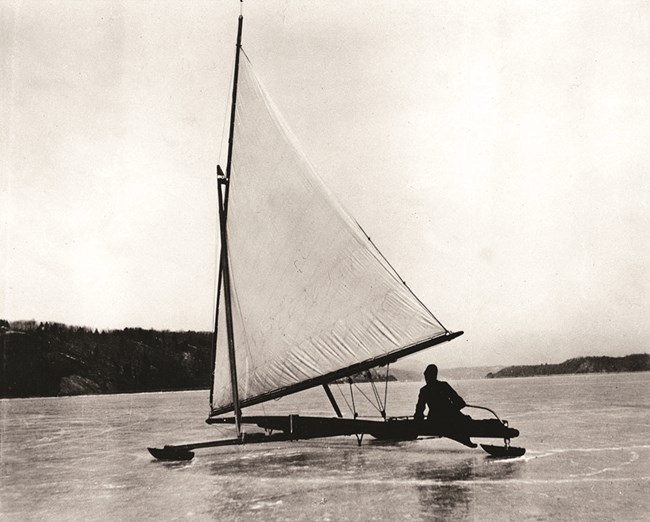
FDR's Ice Yacht
Franklin Delano Roosevelt was especially influenced by this dramatic and romantic sport, from the example of his uncle John Roosevelt, and that of his Hudson Valley neighbors. FDR became passionate about ice yachting as he grew up watching his uncle John compete in races on the Hudson River. John Roosevelt won the prestigious Ice Yacht Challenge Pennant of America and was a founding member of the Hudson River Ice Yacht Club, still in existence today.
Built by George E. Buckhout of Poughkeepsie, New York, the ice yacht HAWK was presented to Franklin Roosevelt by his mother, Sara, as a Christmas gift on December 25, 1901. FDR sailed and raced the HAWK on the Hudson River chiefly during the years he was a student at Harvard. Today, the HAWK is preserved as part of the museum collection at the Home of Franklin D. Roosevelt National Historic Site.
You Might Also Like
- home of franklin d roosevelt national historic site
- hudson river
- franklin d. roosevelt
Home Of Franklin D Roosevelt National Historic Site
Last updated: November 19, 2020

Renegade Iceboats
Rooted in dn & skeeter design.
Elmer Millenbach’s timeless design introduced much of what modern ice yachting is today.
Organized in 1947
About the renegade iceboat.

Steve Schalk, Secretary/Treasurer of Northwest and ISA, has dedicated countless hours to preserving 75 years of essential iceboating history from the International Skeeter Association newsletter, News and Views. In the past few days, I’ve uploaded the PDFs to iceboat.org, making the complete archive easily accessible on the website. It’s a privilege to share this invaluable resource with everyone. Visit the ISA News & Views archives here.
Welcome to the News and Views Archive. This collection has been digitized in searchable pdf format directly from the official document collections of the International Skeeter Association and the Northwestern Ice Yachting Association. In the 1950’s and earlier, the two Associations published documents such as meeting minutes and race results separately. Beginning in the 1960’s, the publication “ISA News and Views” was used to gather and publish news, meeting information, race results, member lists, local club news, and a for sale section. The collection is organized by Iceboat racing season, which stretches from fall of one year through spring of the following year. The order of seasons starts with the most recent and goes back to 1948-49 season. The content gives an insight into developments in iceboating over the last 75 years, with the voices and images of many of the most prominent competitors, designers and builders appearing in these pages. I hope you enjoy your journey back in time using these archives. LINK TO ARCHIVES Steve Schalk Secretary/Treasurer Northwestern Ice Yachting Association INTERNATIONAL SKEETER ASSOCIATION
Reflections & Resolutions – 4LIYC Meeting Recap
by Deb Whitehorse | Mar 7, 2024

Despite the shortness of this sailing season, we are always optimistic and are already laying the groundwork for an exceptional season ahead. The club is gearing up to host the Southern Wisconsin Iceboat Swap Meet next fall and brainstorming ways to make it an unmissable event. Video link to Ice Sailors Irish Blessing.

Eight Bells: Tim McCormick
by Deb Whitehorse | Mar 6, 2024
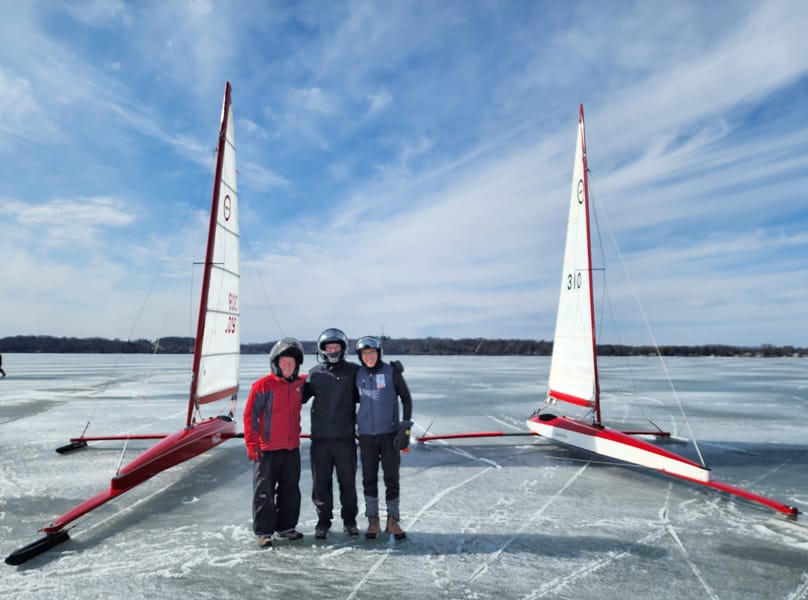
Peter, Tim, and Greg McCormick on Lake Kegonsa, March 2023
OBITUARY INFORMATION Visitation & Funeral 11 AM Friday, March 15, 2024 Monona Terrace and Convention Center 1 John Nolen Dr. Madison, WI 53703 The Four Lakes Ice Yacht Club mourns the loss of our esteemed member, Tim McCormick, who passed away early this morning after a prolonged illness.

We extend our deepest condolences to Tim’s family and friends during this difficult time. More information will be shared as it becomes available.
UPDATE: The ice sailing community is posting tributes and condolences to Tim on the 4LIYC Facebook page. Jane Pegel emailed this last night: “The iceboating community will have a difficult time finding someone to replace Tim McCormick. He was outstanding both on the race course and the time-he devoted to the National Iceboat Authority . With respect, Jane Pegel”
Regatta Watch: ISA & WSSA Postponed Until Dec 2024
by Deb Whitehorse | Mar 3, 2024
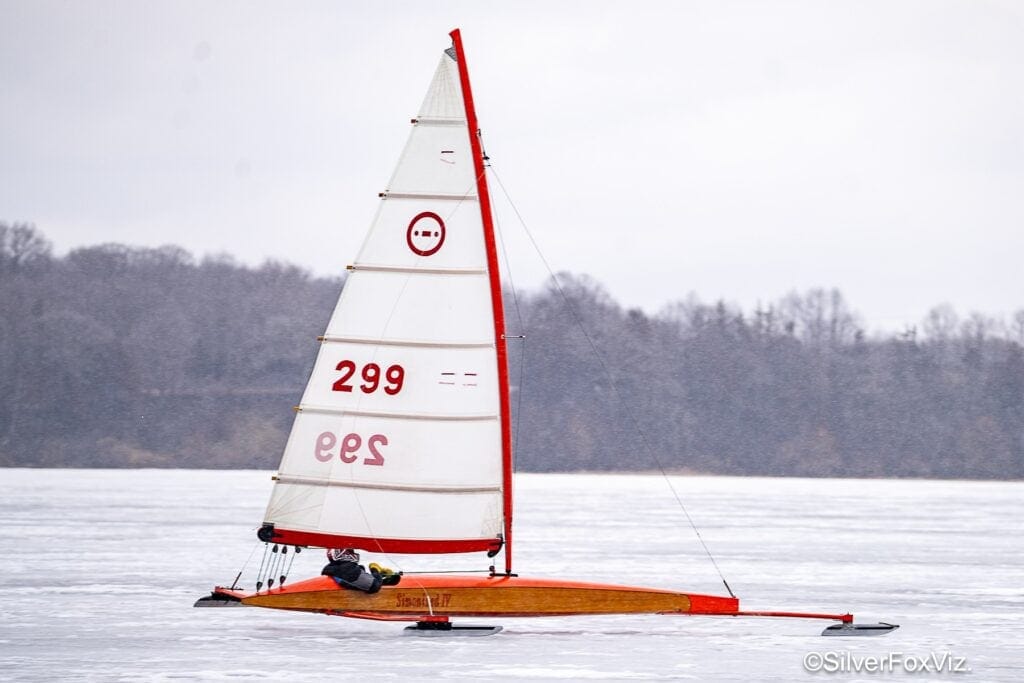
Photo: Shane Lewis – Silverfoxviz – See all Northwest photos here
I NTERNATIONAL SKEETER ASSOCIATION REGATTA The ISA Race Committee has postponed the 2024 Regatta to December 2024. We will be looking for perfect early season ice like we had at Battle Lake Minnesota in 2018. Steve Schalk Secretary/Treasurer International Skeeter Association
WISCONSIN STERN STEERERS ASSOCIATION
The Wisconsin Stern Steering Association regatta has been postponed to December, 2024. Unfortunately this was a short season chasing thin ice. Being optimists, iceboaters always look forward to next season. Andy Gratton WSSA Secretary/Treasurer
Regatta Watch: 2024 ISA Postponed to March 8 – 10
by Deb Whitehorse | Feb 25, 2024
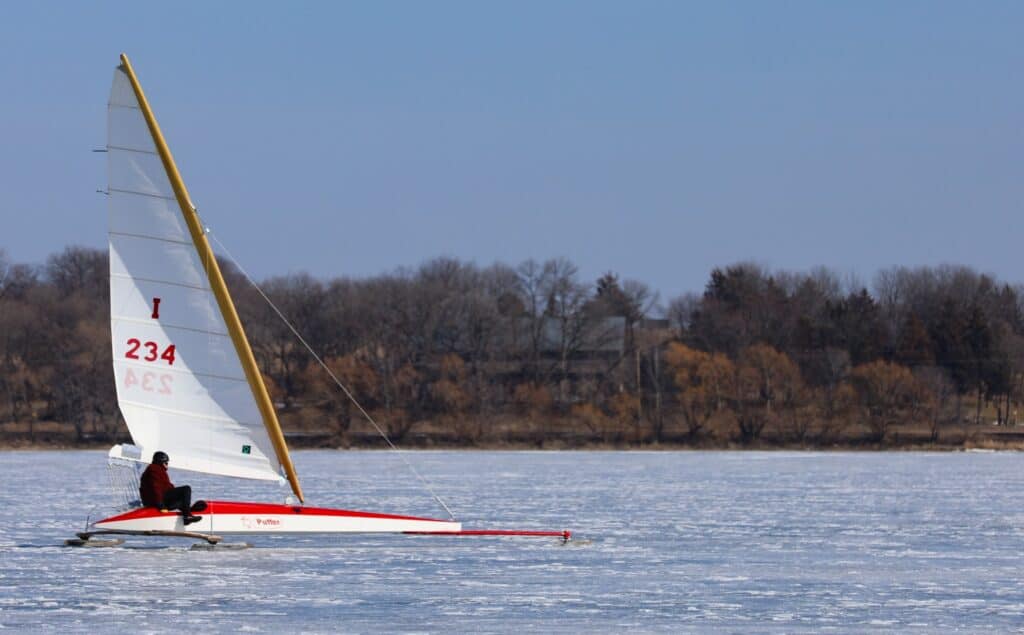
NIYA B Skeeter First Place – Jim McDonagh – Photo: Kevin Barta
The 2024 International Skeeter Association Regatta is postponed until March 8 – 10. Hoping for a cool down after next weekend’s forecasted warm temperatures. Next update, Sunday, March 3, 2024.
2024 Northwest: Day 2 – AM Update
by Deb Whitehorse | Feb 24, 2024
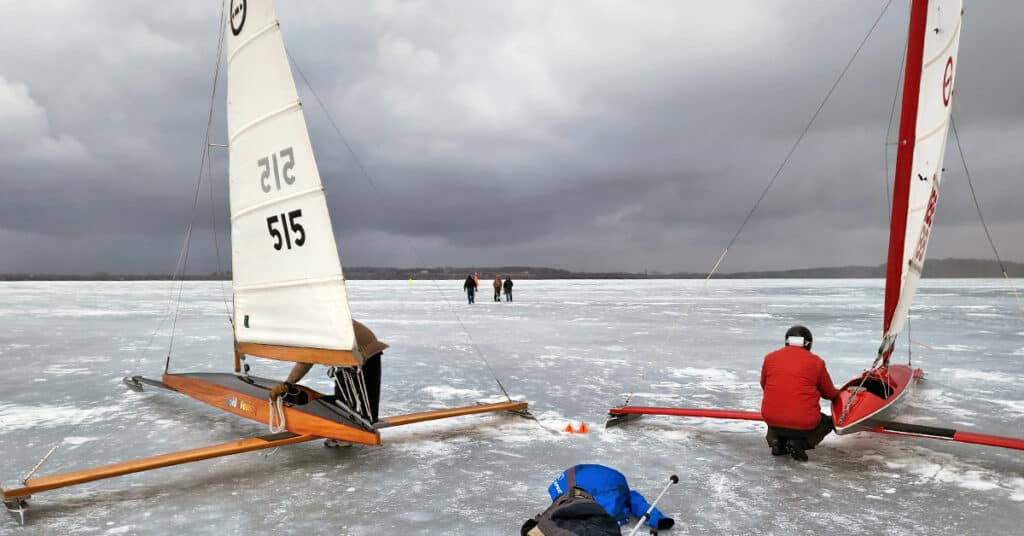
Renegaders Doug Kolner and Mike Derusha at the one and two blocks.
PROVISIONAL RESULTS EVENT PAGE Update – Post updated to include the real location. The webmaster regrets the error and blames it on not enough coffee. The 2024 Northwest Regatta kicked off on Lake WACONIA in Minnesota on Friday, February 23, the first one held in five years.
The winds remained relatively steady throughout most of the day, ranging from 8 to 12 mph. The Race Committee had to reset the course twice. However, as the day progressed, the winds began to fade. The last Stern Steerer, B Skeeter, and DN races were black-flagged because of the time limit.
The bumpy ice conditions tested each sailor’s skills. After each race, sailors had to check all fittings to ensure they remained secure, noted DNer John Harper (US60) from Michigan.
TIME CHANGE FOR FIRST RACE Saturday, February 24, 2024 Schedule Update 9 AM: First Race. Stern Steerers Race #2 Followed by B & C Skeeter Race #2 Normal rotation then resumes: DN Renegade E Skeeter A,B,C,D Stern Steerer ISA B & C Skeeter
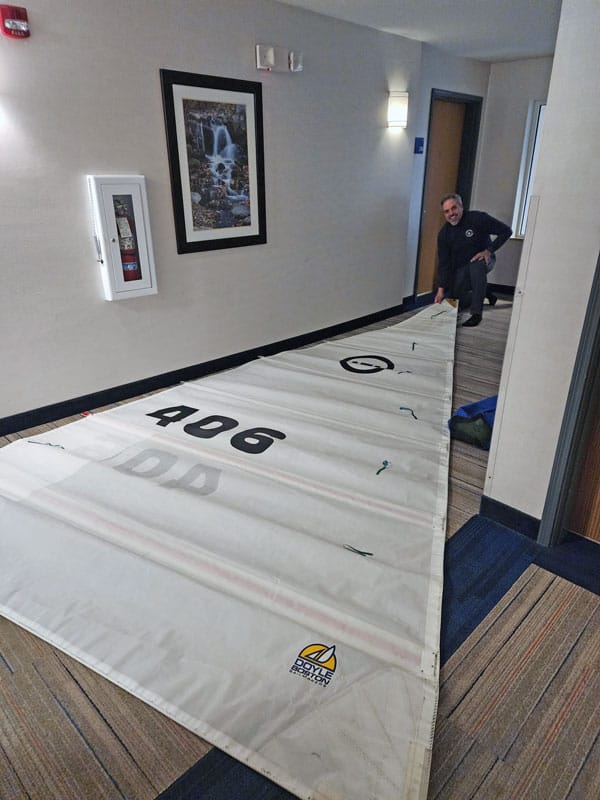
Michigan Renegader Peter Sarelis turns the hotel hallway into a sail loft.
Regatta Watch: NIYA Called ON for Waconia, MN Feb 23-25
by Deb Whitehorse | Feb 20, 2024
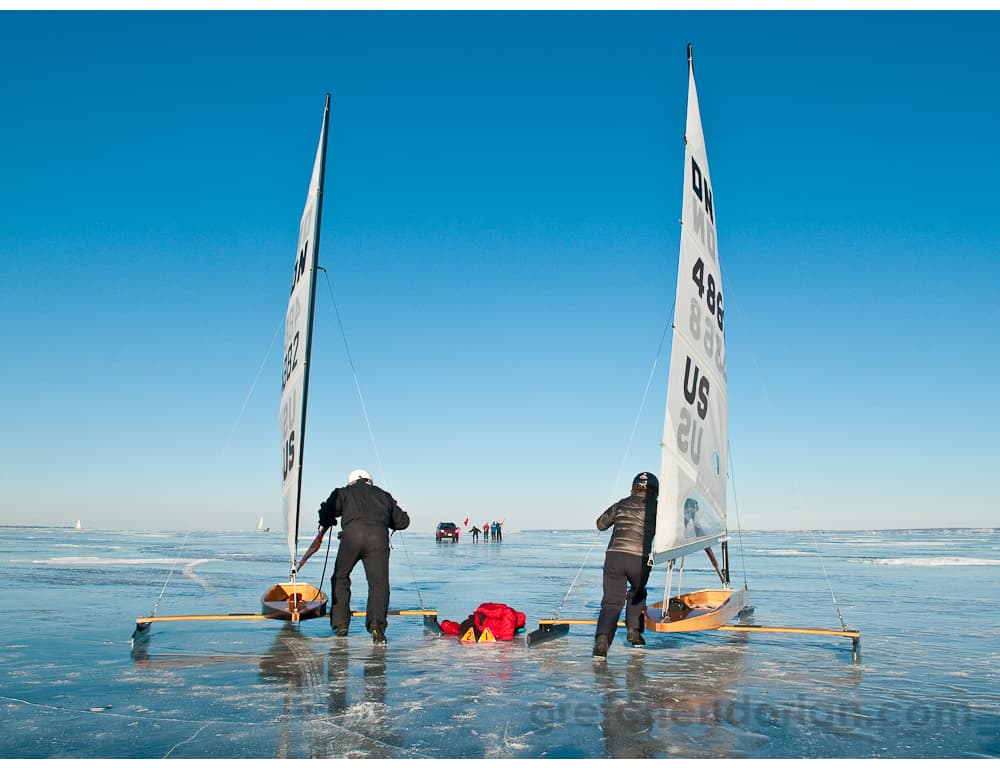
DN Class: Spouses Julie Richards & Dick Wollam draw 1 & 2 for the start at the 2010 Northwest
The Northwestern Ice Yachting Association has called the 2024 championship regatta for February 23-25th at Lake Waconia Minnesota. This is the final call, launch site is Lake Waconia regional park on Paradise lane. Hotel information will be available tomorrow February 21st. The ISA Championship is postponed to March 1st-3rd 2024. Steve Schalk Secretary/treasurer NIYA & ISA
Feb 18, 2024 Regatta Watch: NIYA, ISA & Renegade Championship Called ON for Feb 23-25
by Deb Whitehorse | Feb 18, 2024
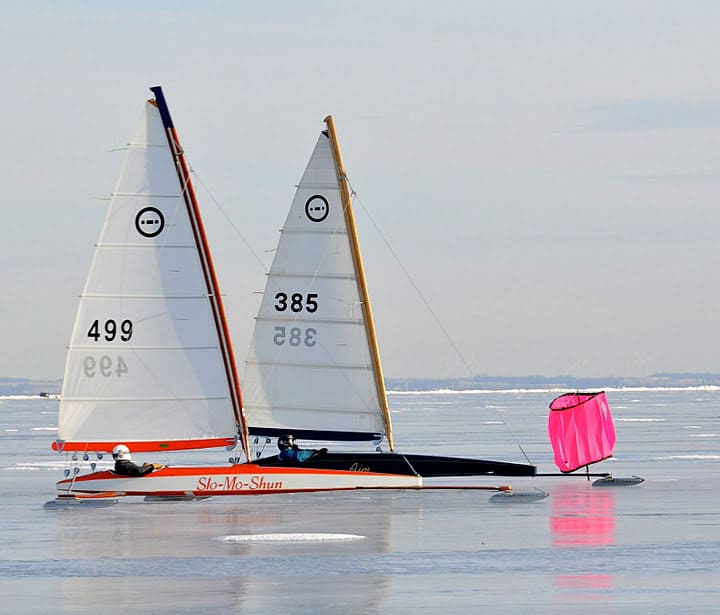
NORTHWEST The Northwestern Ice Yachting Association Race Committee has called the 2024 regatta on for a yet to be determined Minnesota location north and west of St. Cloud. The dates are February 23rd-25th. The lakes are still to be final checked for surface and launch conditions. There are potential lakes in the Alexandria area, where lodging may be an issue, and lakes further north. The final call will be made as soon as possible, but Wednesday February 21st by noon at the latest. ISA The International Skeeter Association Race Committee has made the same call on for February 23rd-25th. In the event the Northwest is held the ISA will defer and postpone. Steve Schalk Secretary/Treasurer NIYA & ISA
A Big Thanks to NIYA & ISA Ice Checkers
by Deb Whitehorse | Feb 15, 2024
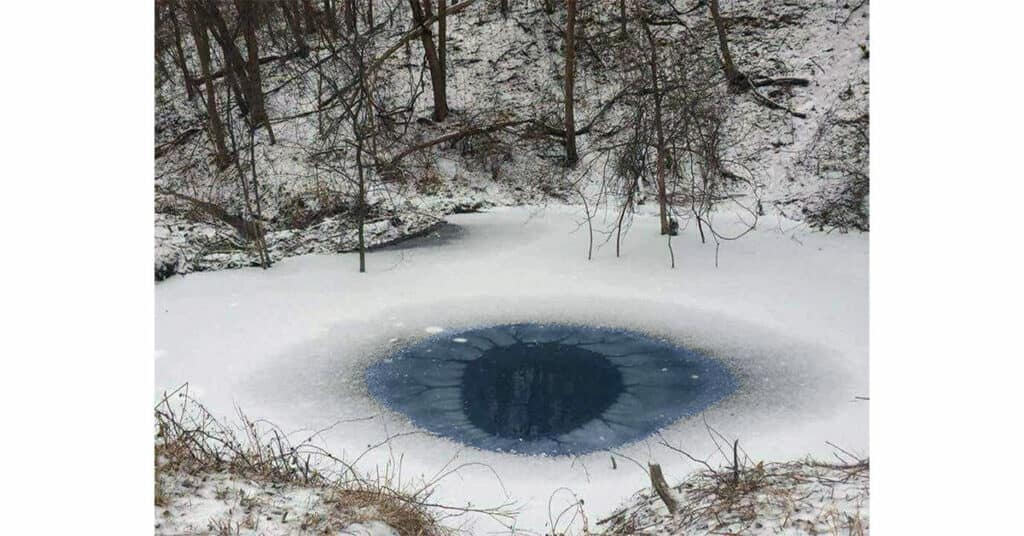
The Race Committees for the Northwest and ISA regattas, would like to acknowledge all the efforts of our ice checkers who have been scouting and sailing potential regatta sites. Pat Heppert and Chris Wiberg spent an entire weekend driving the width of Minnesota setting up their boats and test sailing multiple lakes. Terry Reynolds and Mike Peters sailed Little Bay De Noc, and Jim McDonagh drove up to Lake Osakis on Wednesday at dawn sailed his DN all over the lake, then drove back in a whiteout. We all owe them a big thank you for the huge efforts made to find a place for us to have an event. Many thanks to you guys. Steve Schalk Secretary/Treasurer NIYA & ISA
Feb 14, 2024 Regatta Watch: Postponement for ISA & NIYA
by Deb Whitehorse | Feb 14, 2024
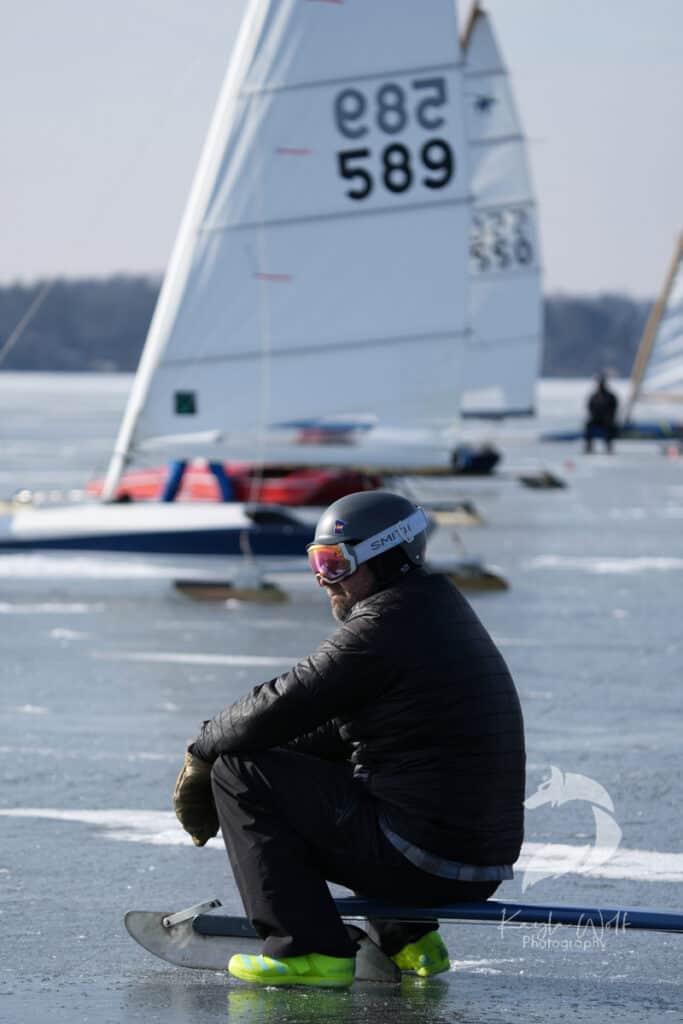
NORTHWEST The Northwestern Ice Yachting Association Race Committee has postponed the 2024 Regatta to February 23rd, 24th, and 25th. A combination of incoming snow, snowy travel, 5.5 rated surface with high winds forecast led to the postponement. ISA The International Skeeter Association Race Committee has postponed one week to February 23rd-25th. If the Northwest is held that weekend the ISA will defer. Steve Schalk Secretary/Treasurer NIYA & ISA
Regatta Archives
- 2022 Lake Monona, Madison, WI
- 2021 Green Lake, WI
- 2020 Lake Puckaway, Princeton, WI
- 2019 Lake Pepin, Lake City, Minnesota
- 2018 Lake Puckaway, Montello, Wisconsin
- 2017 Battle Lake, Minnesota
- 2016 Green Bay, WI
- 2015 Gladstone, Michigan
- 2014 Lake Puckaway
- 2013 Lake Kegonsa
- 2012 No Regatta
- 2011 Lake Mendota
- 2010 No Regatta
- 2009 Green Lake
- 2008 Geneva Lake
- 2007 Toledo, Ohio
- 2005 Geneva Lake
Renegade Website Archives
- Old Renegade Site
Renegades for Sale
September 23, 2024: renegades in wi.
Sep 23, 2024
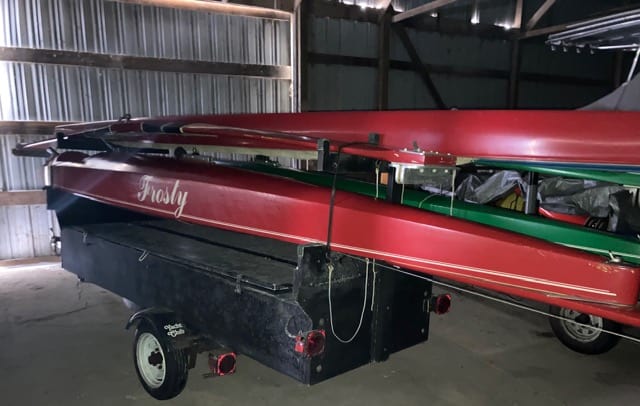
September 9, 2024: Renegade & DN Equipment in WI/RI
Sep 9, 2024
Renegade sails Henry North-$950 Boston “magic”-$800 3 Renegade padded runner carry bags-$200
DN Equipment- Forstmann Boom with blocks-$900 C2/Sherry plank w/ Struble chocks- $900 Plank with chocks-$300 MBC carbon mast 2023/2024- 1-blank tube 1-ready to go MBC mandrel Hybrid mast blank tube- $1200 Boston/North F01- Brand New never used, stored in climate controlled space- $1000 North APP and Max Power. Light use, excellent condition- $1000/ea 1D New and lightly used Power Gold, F Speed and Vertical F Speed. Glass or Carbon Battens avaliable Sarns Black ecoated front plate w/ brake freshly sharpened and tuned- $275
Equipment located in Madison or RI Contact: Chad Atkins [email protected]
January 29, 2024: Renegade w C-Rig in WI
Jan 29, 2024
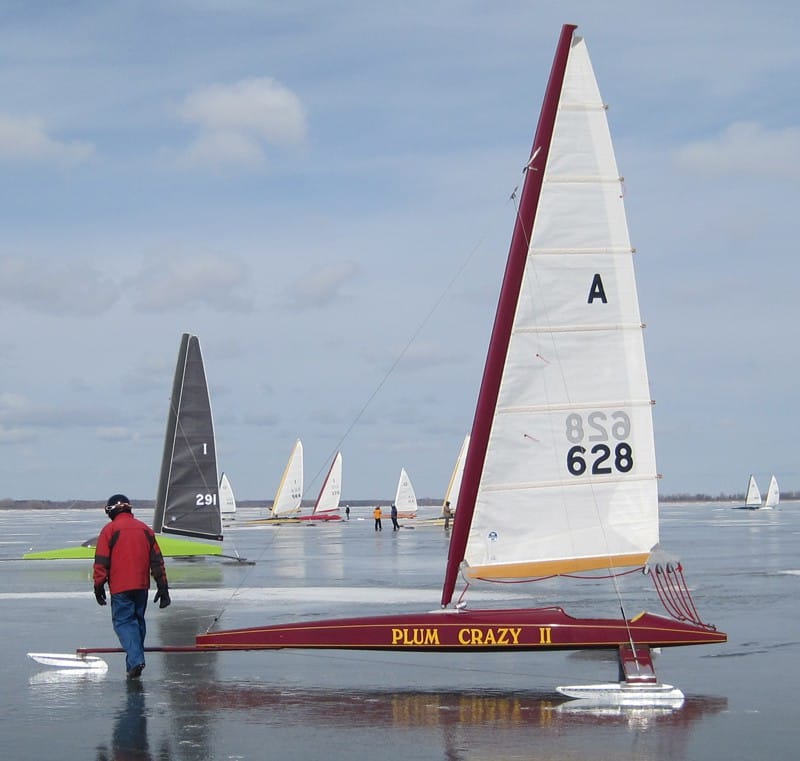
January 3, 2024: Renegades & C-Rigs in Madison, WI
Jan 3, 2024
Renegades for sale. Very competitive $4500 each
C-Rig with mast, boom, and sail $1500
Iceboat trailer $500
Madison, WI area Don Anderson [email protected]
December 11, 2023: Renegade in WI
Dec 11, 2023
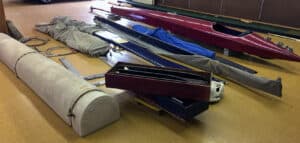
November 27, 2023: Renegade in MI
Nov 27, 2023
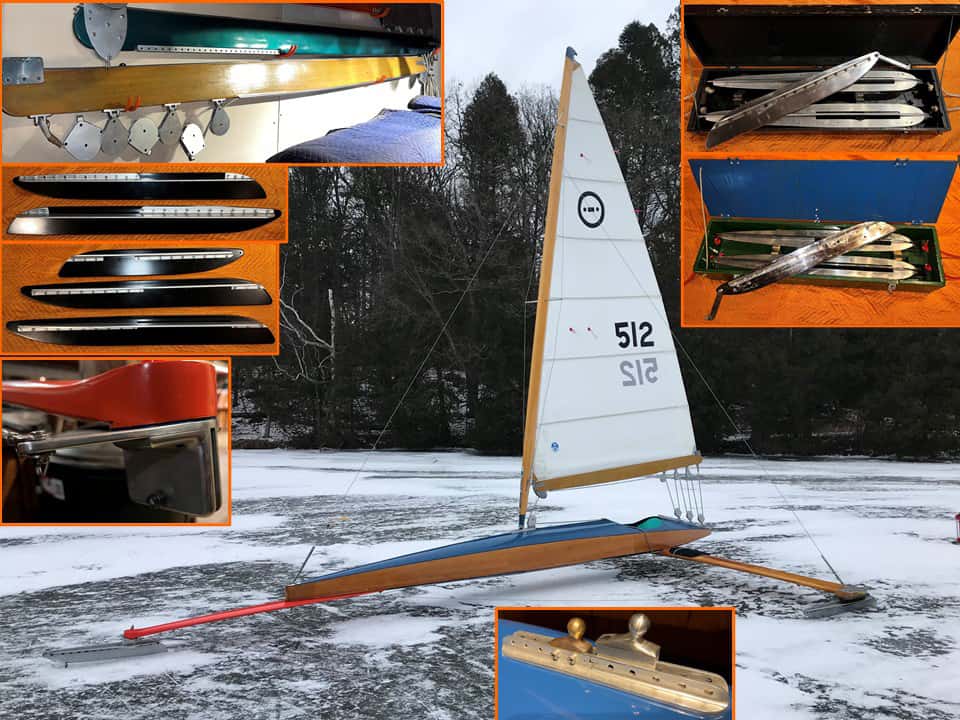
October 19, 2023: Renegade in MI
Oct 19, 2023
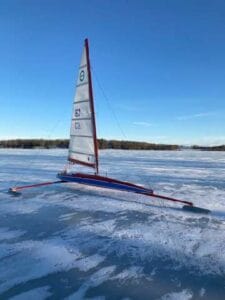
Share this:

An iceboat (occasionally spelled ice boat or traditionally called an ice yacht ) is a recreational or competition sailing craft supported on metal runners for traveling over ice. One of the runners is steerable. Originally, such craft were boats with a support structure, riding on the runners and steered with a rear blade, as with a conventional rudder . As iceboats evolved, the structure became a frame with a seat or cockpit for the iceboat sailor, resting on runners. Steering was shifted to the front.
Evolution of design
Attainable speeds, race courses, iceoptimist, international dn, monotype xv, external links.
Because of their low resistance to forward motion over ice, iceboats are capable of speeds exceeding 60 miles per hour (100 km/h) . Because of their speed, iceboats are used both for recreation and for racing. Racing craft typically carry one person.
A related activity, land sailing , employs sailing craft similar to iceboats, but riding on wheels instead of runners.

The history of iceboating began in Europe in areas where smooth ice was found in the bays of the Baltic Sea and the canals of the Netherlands during the little ice age . Initially boats were used for commerce, but soon evolved into pleasure craft—"ice yachts". Ice sailing came to North America, where the sailing craft evolved into recreational and racing versions.
Iceboating began in the 17th century as a documented means of transport on the frozen Gulf of Riga and the canals of the Netherlands into the 18th century. [1] Ice boats carried cargo on Dutch canals during the 17th century. [2]
The first iceboats were introduced on New York State's Hudson River in the United States in 1790, where the practice flourished as a sport. The first recorded boat, built in 1790 by Oliver Booth of Poughkeepsie , was a square box atop three runners, the two forward runners being nailed to the box and the third acted as a rudder operated by a tiller. This type of craft was accessible to sportsmen of modest means. [3]
In the mid-19th century, two "ice yachting" clubs had formed, the Poughkeepsie Ice Yacht Club (1865) and the Hudson River Ice Yacht Club (1870), where wealthy boat owners sailed large iceboats with up to seven crew members. Boats were as long as 69 feet (21 m) and sailed as fast as 107 miles per hour (172 km/h) , a record exceeding any other conveyance in 1885, set by the Icicle . [1] The first American Challenge Pennant occurred in 1881 on the Hudson river with five ice-yacht clubs competing. Races were sailed five times around a triangular course with one-mile legs, two of which were to windward. Iceboats were divided into four classes with sail areas ranging from less than 300 square feet to over 600 square feet. [4]
By the beginning of the 20th century, iceboating had spread to Minnesota ( Lake Minnetonka and White Bear Lake ), Wisconsin ( Lake Winnebago and Lake Pepin ), Michigan ( Lake St. Clair ), and venues in Maine and Vermont. In Canada, there were venues on Lake Ontario (Kingston) and the Saint Lawrence River . [4]
A European ice sailing club formed first in Sweden (1901), followed by the European Ice Yachting Union, which formed in 1928 with member states Latvia, Lithuania, Estonia, Sweden, Austria, and Germany. [1]
17th-century Dutch ice yachts consisted of flat-bottomed sailboats atop a cross-wise plank, resting on outboard metal runners, which carried the bulk of the weight of the craft. At the stern was a steering runner, attached to a rudder-like structure. to which are affixed four steel runners, one each at bow, stern and each end of the planking. These boats used conventional gaff mainsails and jibs, attached to the mast by travellers. A tiller or wheel stern controls the steering runner. [4]
In the 19th century iceboats evolved into a box, riding on cross-pieces, supported by runners. These "stern-steerer" iceboats were generally rigged as sloops , with a jib sail forward of the mast, although the catboat style with a single sail was also used. [3] In 1879 the archetypical Hudson River iceboat began to emerge. The Robert Scott , designed and built by H. Relyea, had a single backbone and wire guy-ropes. The mast on subsequent boats were stepped further forward than in the past with shortened jibs were shortened and the center of effort and resistance brought into balance, aligning both with the main runners. [5] The shallow cockpit box became elliptical. [4] A few "Class A '' stern steerers with at least 250 square feet (23 m 2 ) of sail area survived in to the late 20th century. [6]
In the early 1900s some smaller iceboats, called scooters , were designed to traverse both ice and water with a shallow, oval 15×5 feet (4.6×1.5 m) hull on fixed runners. These sailing craft were steered by manipulating the sails, there being no rudder. [4]

The traditional stern-steerer boats were largely replaced by front steering boats in the 1930s, following the development of this style by Walter Beauvois of Williams Bay, Wisconsin in a boat named the Beau Skeeter . [2] This boat led to the "Skeeter" class, and the Skeeter Ice Boat Club formed on Geneva Lake , Wisconsin. The Skeeter class adopted the logo of a mosquito on their sail, and has evolved into an aerodynamically clean machine. The Skeeter class is limited to just 75 square feet (7.0 m 2 ) of sail. [7]
In 1937, The Detroit News sponsored a new home-buildable ice boat design, which became the International DN . In 1968 Dick Slates of Pewaukee, Wisconsin designed and built the Nite with two wooden prototypes. The design was refined and fiberglass production began in 1970. [5]

Iceboats designs dating from the mid 20th century onwards typically consist of a triangular or cross-shaped frame, supported by three skate blades called "runners", with the steering runner in front. Runners are made of iron or steel with sharpened edges, which hold onto the ice, preventing slippage sideways from the lateral force of the wind developed by the sails, as they develop propulsive lift . Given their low forward resistance, iceboats can sail up to five times the speed of the true wind. [8] [9] Because the velocity of the iceboat (V B ) is so much greater than the true wind velocity (V T ), the apparent wind (V A ) is only a few degrees from the direction of travel on most points of sail and the sail is close-hauled in each. V A is generated by the combination of iceboat velocity (V B ) and true wind velocity (V T ). [10]
Different classes of iceboat can achieve speeds, as follow.
- International DN: 55–68 miles per hour (89–109 km/h) . [8] [11]
- Skeeter: 84 miles per hour (135 km/h) .
- Classic iceboats: While claimed speeds for such craft have been as high as 140 miles per hour (230 km/h) in the early 20th century, [12] other sources cast doubt on both the technology for achieving and for measuring such speeds at those times. [13]
Because of the high boat speeds, iceboat race courses are established around fixed marks which are to be rounded in a one-way route, enhancing boat-to-boat traffic safety. The courses are a straight line upwind and downwind , which necessitates tacking upwind and jibing downwind. [1]
Among the classes of iceboat are sailing craft that have associations in Europe and North America: IceOptimist, International DN, and Monotype XV. Others are regional in North America: Nite, Renegade, and Skeeter.

The IceOptimist is a youth iceboat class that uses the sails and the rig of the International Optimist dinghy . The first design was built in Estonia in 1978, with scaled-down elements of a DN . In 2002, the class was registered under the guardianship of IDNIYRA Europe with the permission of IODA . World and European Championships are sailed each winter with a fleet of approximately 40 racers. [14]
The International DN class is the most popular class in both North America, Europe and Asia. [ citation needed ] It is a one-person wood boat twelve feet long with a cross-plank eight feet long that carries a mast 16 feet (4.88 m) high. Modern competitive DNs use flexible masts commonly made of composite materials. [15] The DN 60 derives its name from the 1937 request of The Detroit News for a high-performance, inexpensive, home-built iceboat design. Modern DNs share many one-design features with the original boat, including the basic aerodynamic fuselage design, runner configurations and 60 square feet (5.6 m 2 ) of high-performance sail. [16]
The Monotype XV is a class of stern-steering iceboat based on a 1932 design by an Estonian, Erik von Holst . It may be single or double-handed. The One-Design class is built according to close specifications, little changed since the 1930s. It is the largest one-design iceboat class in Europe and the only double-handed iceboat class for which there are international championships. The 205-kilogram (452 lb) is 7.5×4.2 metres (25×14 ft) in length and width with a 7.2-metre (24 ft) high mast. [17]
Nite is a class of iceboat that has a two-seat side-by-side fiberglass fuselage and a 67-square-foot (6.2 m 2 ) sail. It is constructed according to tight specifications. [18]
The Renegade is a class of home-built iceboat whose prototype appeared in 1947 in Wisconsin, designed by Elmer Millenbach to be carried atop an automobile. [19] Plans were published in 1950. [20] It has a 67-square-foot (6.2 m 2 ) sail on a flexible aerodynamic spar. [9]
The Skeeter class is divided into sub-classes (A, B and C) all of which are limited to 75 square feet (7.0 m 2 ) of sail area. [21] A-class boats may be single or two-place tandem with a mast that does not exceed 28.5 feet (8.7 m) . They may incorporate carbon fiber construction. [16] B-class boats have seats for two (side by side). C-class skeeters may be single or two-place tandem with a mast that does not exceed 20.25 feet (6.17 m) . [22]
- Land sailing
- Northumberland Strait iceboat
Related Research Articles

Sailing employs the wind—acting on sails, wingsails or kites—to propel a craft on the surface of the water , on ice (iceboat) or on land over a chosen course, which is often part of a larger plan of navigation.
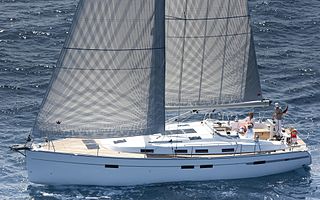
A yacht is a sail- or motor-propelled watercraft made for pleasure, cruising, or racing. There is no standard definition, though the term generally applies to vessels with a cabin intended for overnight use. To be termed a yacht , as opposed to a boat , such a pleasure vessel is likely to be at least 33 feet (10 m) in length and may have been judged to have good aesthetic qualities.
A point of sail is a sailing craft's direction of travel under sail in relation to the true wind direction over the surface.
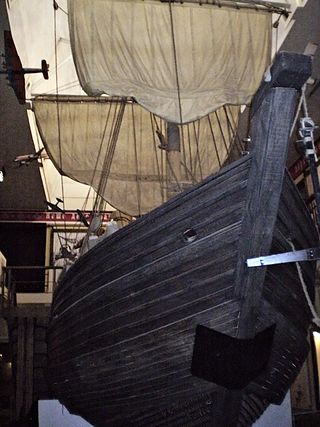
The koch was a special type of small one- or two-mast wooden sailing ships designed and used in Russia for transpolar voyages in ice conditions of the Arctic seas, popular among the Pomors.

The Optimist is a small, single-handed sailing dinghy intended for use by young people up to the age of 15.
Tacking or coming about is a sailing maneuver by which a sailing craft, whose next destination is into the wind, turns its bow toward and through the wind so that the direction from which the wind blows changes from one side of the boat to the other, allowing progress in the desired direction. Sailing vessels are unable to sail higher than a certain angle towards the wind, so "beating to windward" in a zig-zag fashion with a series of tacking maneuvers, allows a vessel to sail towards a destination that is closer to the wind that the vessel can sail directly.
The International DN is a class of iceboat. The name stands for Detroit News, where the first iceboat of this type was designed and built in the winter of 1936–1937. Archie Arrol was a master craftsman working in the Detroit News hobby shop, and together with iceboaters Joe Lodge and Norman Jarrait designed a racing boat they called the "Blue Streak 60", later to become known as the "DN 60". In 1937 a group of 50 laymen worked with Archie in the hobby shop to produce the first fleet of the new iceboats. These first boats broke during the initial season, and after Jarrait and Lodge modified the design to increase the strength, the group got back together to build a second set of iceboats in 1938.

Land sailing , also known as sand yachting , land yachting or dirtboating , entails overland travel with a sail-powered vehicle, similar to sailing on water. Originally, a form of transportation or recreation, it has evolved primarily into a racing sport since the 1950s.

The Moth is a small development class of sailing dinghy. Originally a small, fast home-built sailing boat designed to plane, since 2000 it has become an expensive and largely commercially produced boat designed to hydroplane on foils though many are still built at home, typically at much lower cost.

A sailing hydrofoil , hydrofoil sailboat , or hydrosail is a sailboat with wing-like foils mounted under the hull. As the craft increases its speed the hydrofoils lift the hull up and out of the water, greatly reducing wetted area, resulting in decreased drag and increased speed. A sailing hydrofoil can achieve speeds exceeding double and in some cases triple the wind speed.

A sailing yacht , is a leisure craft that uses sails as its primary means of propulsion. A yacht may be a sail or power vessel used for pleasure, cruising, or racing. There is no standard definition, so the term applies here to sailing vessels that have a cabin with amenities that accommodate overnight use. To be termed a "yacht", as opposed to a "boat", such a vessel is likely to be at least 33 feet (10 m) in length and have been judged to have good aesthetic qualities. Sailboats that do not accommodate overnight use or are smaller than 30 feet (9.1 m) are not universally called yachts. Sailing yachts in excess of 130 feet (40 m) are generally considered to be superyachts.

The Butterfly is a one-design sailing dinghy, originally designed for a crew of two, but now most commonly raced single-handed. It was designed in 1961 in Libertyville, Illinois by John Barnett. The 12-foot (3.7 m) hull is a scow design. The craft has a stayed 18-foot (5.5 m) mast set as a Marconi rig with a single mainsail with a 75-square-foot (7.0 m 2 ) surface area. The cockpit is 15 ½" deep, exceptionally deep for this size of sailboat, and can accommodate an adult up to 6 feet in height.

Wind-powered vehicles derive their power from sails, kites or rotors and ride on wheels—which may be linked to a wind-powered rotor—or runners. Whether powered by sail, kite or rotor, these vehicles share a common trait: As the vehicle increases in speed, the advancing airfoil encounters an increasing apparent wind at an angle of attack that is increasingly smaller. At the same time, such vehicles are subject to relatively low forward resistance, compared with traditional sailing craft. As a result, such vehicles are often capable of speeds exceeding that of the wind.

High-performance sailing is achieved with low forward surface resistance—encountered by catamarans, sailing hydrofoils, iceboats or land sailing craft—as the sailing craft obtains motive power with its sails or aerofoils at speeds that are often faster than the wind on both upwind and downwind points of sail. Faster-than-the-wind sailing means that the apparent wind angle experienced on the moving craft is always ahead of the sail. This has generated a new concept of sailing, called "apparent wind sailing", which entails a new skill set for its practitioners, including tacking on downwind points of sail.
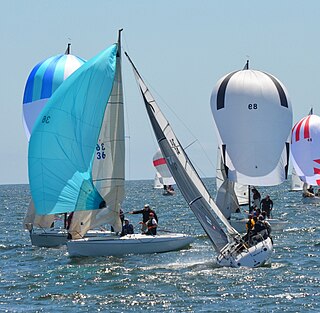
Forces on sails result from movement of air that interacts with sails and gives them motive power for sailing craft, including sailing ships, sailboats, windsurfers, ice boats, and sail-powered land vehicles. Similar principles in a rotating frame of reference apply to windmill sails and wind turbine blades, which are also wind-driven. They are differentiated from forces on wings, and propeller blades, the actions of which are not adjusted to the wind. Kites also power certain sailing craft , but do not employ a mast to support the airfoil and are beyond the scope of this article.
The Water Wag is the oldest one-design dinghy in existence, having been devised in 1886 and formalised as a one-design class in Ireland in 1887. It was last modified in 1900. The class is still sailed to this day, notably with large Water Wag fleets racing during summer evenings from Dún Laoghaire harbour on Dublin Bay. The Water Wag class is administered by the Water Wags club, based in Dún Laoghaire.
The following outline is provided as an overview of and topical guide to sailing:

The Mary Taylor was a 19th-century yacht and Sandy Hook pilot boat, built at the Hathorne & Steers shipyard in 1849 for Captain Richard Brown. She was designed by George Steers with a new radical design with a long thin bow and wide stern, which made her faster than any other boat in her class. This design proved successful and led to the famous yacht America, which won the America's Cup in 1851. The Mary Taylor sank after colliding with the schooner Fairhaven in 1863. She was replaced by the Mary E. Fish .
Jane Wiswell Pegel is an American sailor, on water and on ice, who was elected into the United States' National Sailing Hall of Fame in 2021.

A sail plan is a drawing of a sailing craft, viewed from the side, depicting its sails, the spars that carry them and some of the rigging that supports the rig. By extension, "sail plan" describes the arrangement of sails on a craft. A sailing craft may be waterborne, an iceboat, or a sail-powered land vehicle.
- 1 2 Spectre, Peter H. (2006). A mariner's book of days, 2007 . Dobbs Ferry, NY: Sheridan House. ISBN 1-57409-226-X . OCLC 173009383 .
- 1 2 Levine, David (November 19, 2013). "Explore the History of Ice Yachting in the Hudson Valley" . www.hvmag.com . Retrieved April 14, 2020 .
- 1 2 3 4 5 Chisholm, Hugh , ed. (1911). "Ice-Yachting" . Encyclopædia Britannica . Vol. 14 (11th ed.). Cambridge University Press. p. 241 – 242.
- 1 2 Fisher, Daniel (March 7, 2014). "As The Hudson River Freezes, Classic Ice Yachts Emerge" . Forbes . Retrieved April 15, 2020 .
- ↑ Bentsen, Ellen (January 1981). Wisconsin Ice Monsters . Yachting. pp. 61–3.
- ↑ Andrews, Candice Gaukel (2006). Great Wisconsin Winter Weekends . Big Earth Publishing. p. 152. ISBN 978-1-931599-71-9 .
- 1 2 Dill, Bob (March 2003), "Sailing Yacht Design for Maximum Speed" , The 16th Chesapeake Sailing Yacht Symposium , Anapolis: SNAME, archived from the original (PDF) on September 19, 2020 , retrieved January 29, 2017
- 1 2 "Commonly Asked Questions" . Four Lakes Ice Yacht Club. Archived from the original on March 9, 2011 . Retrieved August 25, 2010 .
- ↑ See page 204 of Bethwaite, Frank (2007). High Performance Sailing . Adlard Coles Nautical. ISBN 978-0-7136-6704-2 .
- ↑ Dill, Bob (February 2004). "Putting Numbers on Iceboat Performance" (PDF) . International DN Ice Yacht Racing Association Newsletter .
- ↑ Smith, Doug (January–February 2004). Sailing on slivers of steel . Boy Scouts of America, Inc. pp. 17–21.
- ↑ Dill, Bob (March 2004). "Sailing Yacht Design for Maximum Speed" (PDF) . The 16th Chesapeake Sailing Yacht Symposium . Anapolis.
- ↑ "ICE OPTI and DN JUNIOR – IDNIYRA – Europe" . idniyra.eu . Retrieved April 10, 2020 .
- ↑ "IDNIYRA | International DN Ice Yacht Racing Association" . December 27, 2017. Archived from the original on December 27, 2017 . Retrieved April 15, 2020 .
- 1 2 Staff (January 1982). "Endless winter, the iceboater's dream" . Changing Times-The Kiplinger Magazine . 36 (1): 58–9.
- ↑ Whitehorse, Deb (March 4, 2019). "Monotype XV European Championship" . iceboat.org . Retrieved April 15, 2020 .
- ↑ "Class Rules" (PDF) . International Nite Class Association . July 30, 2019 . Retrieved April 18, 2020 .
- ↑ Millenbach, Elmer. "The Renegade Story" . iceboat.org . International Skeeter Association . Retrieved April 18, 2020 .
- ↑ Brennan, Walter X. (December 1950). "Building the Renegade Ice Yacht" (PDF) . Science and Mechanics : 181–99.
- ↑ "International Skeeter Association" . iceboat.org . Retrieved April 15, 2020 .
- ↑ Class committee (October 16, 2016). "General rules and regulations of the International Skeeter Association" (PDF) . Retrieved April 14, 2020 .
- DN Class World Portal
- DN North America
- International XV Monotype Association
- International Skeeter Association
- Videos on DN iceboating
| of | |
| Major phases | |
| Formations | ( ) |
| Phenomena | ( ) |
| Ice-related activities | |
- Iceman (occupation)
- Yakhchāl
- Little Ice Age
- Pleistocene
- Snowball Earth
| National | |
|---|---|
| Artists | |
| Other | |
It Was Cold Enough This Winter to Go Ice Yachting on the Hudson River
This high-speed sport only happens when conditions are just right: a frozen river, lots of wind, and cold temperatures
Mary Beth Griggs
/https://tf-cmsv2-smithsonianmag-media.s3.amazonaws.com/filer/8c/d4/8cd435dc-26c1-45d8-aeaf-a8801315cfc4/12927157855_d1436aa710_b.jpg)
Most boat enthusiasts, be they fishermen, yacht owners or sailors, mourn the long, dark days of winter, when the weather is too forbidding to put their boats in the water. But for some groups in the Hudson Valley, the fun is just beginning when the river ices over.
That’s when they can bring out their ice yachts. An ice yacht looks kind of like a sailboat with the boat part cut off—instead, the yachts travel across the water on wooden blades, with only a miniscule seating area for the crew. To the untrained observer, it looks like a cross between a catamaran, windsurfing and ice skating. WNYC reports :
In the late 1800s, ice yacht races regularly drew huge crowds to the frozen Hudson River. The sport faded out as the 20th century rolled on, but the Hudson River Ice Yacht Club is still committed to restoring and sailing these antique wooden boats. After several years with little or no sailing on the river, early March 2014 has brought the perfect conditions—a foot of smooth ice, extending for miles, from North Germantown to Rhinecliff. Ice like this hasn't been seen for a long, long time, and one recent afternoon, it drew a fleet of ice yachts to Astor Point, just north of the Kingston-Rhinecliff bridge.
Ice yachting (also known as ice sailing) is popular in other parts of the world, with World Championships held in Europe, and races held around the world, including on Lake Baikal.

The ice yachts in New York can reach speeds from 40 to 80 miles per hour, skimming across the surface of the ice in the bitter cold. ABC News reported :
The crews are keeping alive a tradition from the 19th century when winter days might bring thousands of people out to the ice at nearby Poughkeepsie to watch the ice boats race, said the Hudson River Ice Yacht Club's John Sperr. "A lot of the old stern-steering boats got rebuilt and put back together and pushed into service. That's our mission right now — to try to keep these old yachts going," Sperr said. "We don't want to put them in a museum where nothing ever happens to them."
Warmer winters mean that the really large yachts can’t go out all that often. But last weekend conditions were right for a few 50-foot-long, century-old boats were able to take another spin on the ice .
Warmer winters haven’t just changed the fun on this side of the Atlantic, either. While ice yachting can still take place in colder climates, the last Frost Fair (basically a massive party) was last thrown on the Thames 200 years ago—the most recent time that the ice froze thick enough for the fair grounds to be constructed on the ice.
Get the latest stories in your inbox every weekday.
Mary Beth Griggs | | READ MORE
Mary Beth Griggs is a freelance science journalist based in New York City.
Today, we go iceboating. The University of Houston's College of Engineering presents this series about the machines that make our civilization run, and the people whose ingenuity created them.
T he sport of iceboating is alien to our warm Texas coast. So the raw intensity of an 1881 Scribner's article, Ice-Yachting on the Hudson, takes me by surprise. Its engravings could pass as concept sketches for a special effects action movie.
Iceboats are lean and spare. A vertical sail rises from a horizontal cross-shaped frame running on three skates. A rudder handle turns the rear skate for steering. Iceboats are well-known in Northern European history. And, until the 20th century, they'd carried humans the fastest they'd ever gone. So this article becomes raw theatre. Iceboats, it says, reach 80 to a 100 miles an hour on clear stretches of smooth ice. It'd be another ten years before a locomotive passed 80 miles an hour -- another 30 before flying machines did so.
We might expect that gale-force winds were needed to get such speeds. They were not. Iceboats move far faster than the winds that propel them. They have a singular advantage over sailboats because they offer such low drag. A cross breeze exerts a modest pulling force on the sail while the boat's motion is nearly perpendicular to that breeze. Since the drag is so low, that small force can sustain a very high speed. A pure tail wind is actually a disadvantage. An iceboat has no way to travel faster than the wind if the wind is right at its back.
So, let's look at pictures: The curious stand about as yachtsmen assemble their boats. Skaters dart around a row of iceboats at a starting line. Riders of a horse-drawn sleigh wave as boats whip past them. Here are iceboats rearing off the ice -- standing on two, or even just one, of their skates. A man stands on an outrigger to keep from overturning while another struggles to steer. And, finally, a dray horse hauls a wrecked boat off the ice.
Like many sports, iceboats have adopted new materials and have taken on a modern look. But nothing as extreme as, say, modern archery with its unrecognizable bows. The official iceboat speed record remains the one set on Lake Winnebago, Wisconsin, way back in 1938. It was (hold your breath) 143 miles an hour.
The writer has just ridden an iceboat and here's his reaction: "You are not shut up in a ponderous train -- a whole world of material, roaring, jolting matter. Here you fly alone through the keen air and flashing sunshine, with the speed of a bird soaring in the sky."
But he realizes that flight, when we achieve it, won't be the same. "Your eyes," he says, "are not those of an eagle." Rather, as you fly inches above the ice, "objects seem melted down and drawn out into blurred, elongated forms." The force of gravity is destroyed and; our bodies seem to lose all material existence.
Now people see the iceboat against the backdrop of hang-gliding and sky-diving. The setting is changed. We need to imagine, say, world-class surf-boarding in a Courier and Ives print, to better understand the immensity of what we find in this old magazine.
I'm John Lienhard, at the University of Houston, where we're interested in the way inventive minds work.
C. H. Farnham, Ice-Yachting on the Hudson. Scribner's Monthly, An Illustrated Magazine for the People, Vol. XII, May to October, 1881, pp. 528-539. (See also, C. H. Farnham, How to Build an Ice-Yacht. pp. 658-665, in the same issue of Scribner's. ) All illustrations from these sources.
Click Here to see Farnham's design of an iceboat.
Click Here to see details of Farnham's design of the rudder and the attached skate.
Click Here to see other rigging details in Farnham's design.
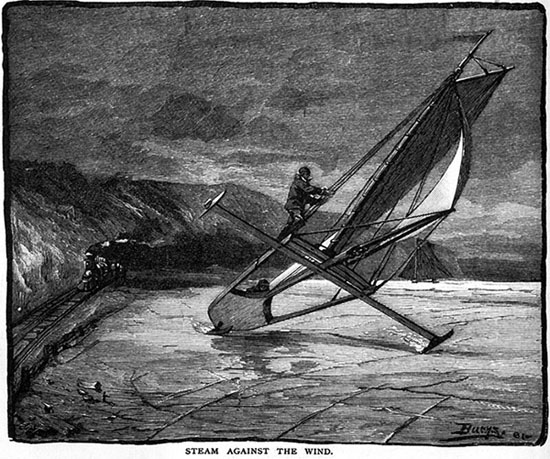
- Engines Transcripts
- Search Episodes by Keyword
- Airing schedule for HPM

IMAGES
VIDEO
COMMENTS
Boer Ice sailing in the Netherlands in 1938. An iceboat (occasionally spelled ice boat or traditionally called an ice yacht) is a recreational or competition sailing craft supported on metal runners for traveling over ice. One of the runners is steerable. Originally, such craft were boats with a support structure, riding on the runners and ...
The Four Lakes Ice Yacht Club is one of the most active ice boat clubs in North America. We've been building and sailing ice boats for over 100 years in Madison, WI, USA. Get started ice boating by learning about the different types of ice boats, how to get started, regattas, history, and so much more.
Ice yachting gave dedicated sailors—including Franklin D. Roosevelt, who helmed an ice yacht called Hawk —something to do in the winter, and the spectacle captivated onlookers, too.
Ice sailing, also known as ice yachting, is a winter sport that offers a unique and exhilarating way to harness the power of the wind. Picture yourself skimming across a frozen lake at breathtaking speeds, the crisp air whipping past as you steer your sleek vessel over the ice. It's sailing, but with a twist—trading water for ice and waves ...
The DN is most popular iceboat in the world. Whether you are a racer or cruiser, your $25 membership in the IDNIYRA helps to promote the art and skill of DN ice yacht construction and the sport of ice yachting on all the hard waters of the world.
Join Our Class. Our Community. The one-design DN ice yacht is easy to transport, light, and relatively inexpensive. Carrying 60 sq ft/ 5.57 sq m of sail, it offers spirited performance and very competitive sailing. Ice yachters, from veterans to juniors, find the DN's demands in competition a satisfying challenge. The DN has evolved into the world's largest iceboat class with active ...
Learn About Ice Boating and How To Get Involved: Ice boats are strictly wind powered and need relatively snow-free ice to sail. We recommend that the novice purchase an inexpensive DN class ice boat a relatively easy boat to transport and sail. We maintain that club racing is much safer than solo cruising.
Known locally as "Skeeter Season" (after the style of ice yachts that were developed in the region) the winter months bring state-of-the-art sailing competitions annually. Skeeters are essentially akin to the "Formula One" boats of ice yachting. They are sleek, aerodynamic speed demons constructed of kevlar and carbon fiber to fly over ...
Across the Atlantic, American sailors wanted a piece of the action. Large ice yachts began appearing on the Hudson and Delaware Rivers in the mid-1800s. Iceboat clubs also emerged. The New Jersey-based North Shrewsbury Ice Boat and Yacht Club formed in 1880 and remains in existence today. Throughout the 1930s and 1940s, ice sailing reached its ...
Intro to Ice Sailing. Photo Courtesy of Minnesota Monthly. An ice boat has four basic parts—the hull, the runner plank, three skates (or runners), and a sail. Ice boats can reach speeds of more than 140 miles per hour. There are two methods of boating: sailing downwind or going upwind.
Discover Fraser's collection of ice class expedition yachts for sale. Cruise the world's most remote destinations in style aboard an ice class explorer yacht.
ICE yacht for sale with Fraser. She is an exceptional motor yacht built by ICE Yachts in 2025 to the highest standards.
Uncover the history of ice yachts on the Hudson River, a utilitarian transport mode that evolved into a leisure sport to the elite!
The Hudson River Ice Yacht Club was known to have the finest-built and fastest ice yachts in the country. The club book of 1908 lists 52 ice yachts in its roster, including John Roosevelt's ICICLE, VIXEN and KRISS, as well as FDR's HAWK. FDR served a term as Vice-Commodore for the club. Franklin D. Roosevelt on his ice yacht, HAWK, ca. 1901.
The Ice Yacht Challenge the era's biggest races, was inaugurated in 1881 by the New Hamburg Ice Yacht Club. Archibald Rogers, a neighbor of Commodore Roosevelt, and his boat Jack Frost raced against the Icicle, Robert Scott, and other boats until 1902. This period was the height of Hudson River ice yachting. By 1903, the Carthage Ice Yacht ...
Originally built in 2012 as a working ice breaker called Sanaborg, the vessel has been transformed into a completely different beast. While Sanaborg was built to fulfil a purpose, to carry cargo ...
About the Renegade Iceboat. The Renegade is an excellent boat for those seeking spirited on-design racing. It has been a winner and trend-setter ever since its unveiling in 1947, providing many of the design features found in today's Skeeters. The Renegade bears 67 square feet of sail on a bendy wing spar, making it a powerful racing yacht in ...
Boer Ice sailing in the Netherlands in 1938. An iceboat (occasionally spelled ice boat or traditionally called an ice yacht) is a recreational or competition sailing craft supported on metal runners for traveling over ice. One of the runners is steerable. Originally, such craft were boats with a support structure, riding on the runners and ...
An ice yacht looks kind of like a sailboat with the boat part cut off—instead, the yachts travel across the water on wooden blades, with only a miniscule seating area for the crew.
Capable of more than four times the wind speed a DN ice yacht can reach 100kph and in a fleet of 50 boats the closing speeds are both alarming and intoxicati...
Ice. (yacht) Ice is a large private yacht, measuring 295 feet (90 m) in length. Launched in 2005 as Air, she was completed at the Lürssen yard in Bremen, Germany to the design of Tim Heywood. The yacht was owned by Russian billionaire Suleyman Kerimov from christening until 2015 when Teodoro Nguema Obiang Mangue of Equatorial Guinea acquired ...
The sport of iceboating is alien to our warm Texas coast. So the raw intensity of an 1881 Scribner's article, Ice-Yachting on the Hudson, takes me by surprise. Its engravings could pass as concept sketches for a special effects action movie.
A champion ice yacht racer, Roosevelt's boat — at 68-feet, 10-inches long and boasting a sail spread of 1,070 square feet — was the largest ice boat in the world at the time.